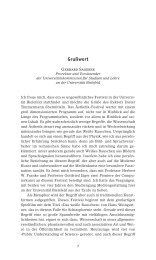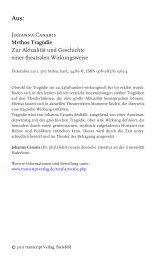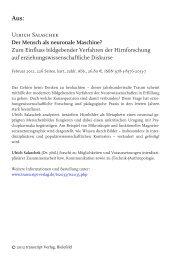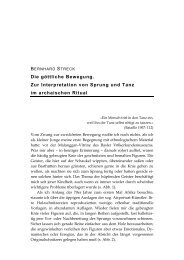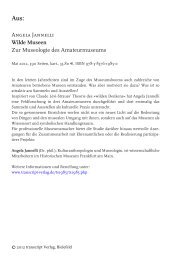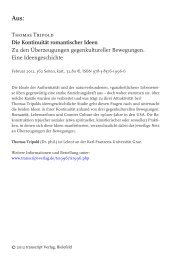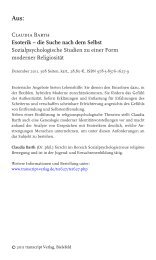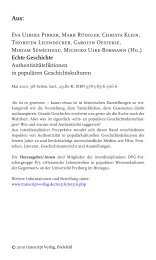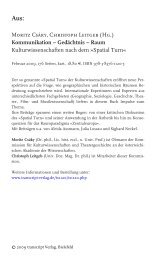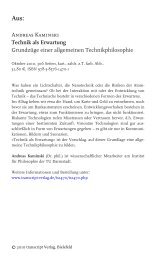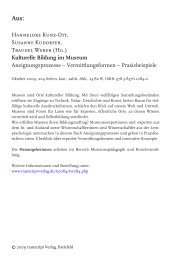Julia Straub (ed.) Paradoxes of Authenticity Studies on a Critical ...
Julia Straub (ed.) Paradoxes of Authenticity Studies on a Critical ...
Julia Straub (ed.) Paradoxes of Authenticity Studies on a Critical ...
Create successful ePaper yourself
Turn your PDF publications into a flip-book with our unique Google optimized e-Paper software.
From:<br />
<str<strong>on</strong>g>Julia</str<strong>on</strong>g> <str<strong>on</strong>g>Straub</str<strong>on</strong>g> (<str<strong>on</strong>g>ed</str<strong>on</strong>g>.)<br />
<str<strong>on</strong>g>Paradoxes</str<strong>on</strong>g> <str<strong>on</strong>g>of</str<strong>on</strong>g> <str<strong>on</strong>g>Authenticity</str<strong>on</strong>g><br />
<str<strong>on</strong>g>Studies</str<strong>on</strong>g> <strong>on</strong> a <strong>Critical</strong> C<strong>on</strong>cept<br />
January 2012, 284 p., 32,80 €, ISBN 978-3-8376-1819-8<br />
<str<strong>on</strong>g>Authenticity</str<strong>on</strong>g> is <strong>on</strong>e <str<strong>on</strong>g>of</str<strong>on</strong>g> the most crucial, but also most c<strong>on</strong>test<str<strong>on</strong>g>ed</str<strong>on</strong>g> c<strong>on</strong>cepts in<br />
literary and cultural studies. Hollow<str<strong>on</strong>g>ed</str<strong>on</strong>g> out by postmodernist theory, it paradoxically<br />
enough persists as an important backdrop for the discussi<strong>on</strong> <str<strong>on</strong>g>of</str<strong>on</strong>g> literature,<br />
film, and the visual arts. The essays in this volume explore perspectives<br />
<strong>on</strong> authenticity and case studies dealing with »the authentic«. They thereby<br />
seek to show how the paradoxical persistence <str<strong>on</strong>g>of</str<strong>on</strong>g> authenticity in c<strong>on</strong>temporary<br />
critical discourse can be turn<str<strong>on</strong>g>ed</str<strong>on</strong>g> into a fruitful point <str<strong>on</strong>g>of</str<strong>on</strong>g> departure for an analysis<br />
<str<strong>on</strong>g>of</str<strong>on</strong>g> literary texts, but also films, and the visual arts.<br />
<str<strong>on</strong>g>Julia</str<strong>on</strong>g> <str<strong>on</strong>g>Straub</str<strong>on</strong>g> is a senior lecturer in North American Literature at the University<br />
<str<strong>on</strong>g>of</str<strong>on</strong>g> Berne (Switzerland).<br />
For further informati<strong>on</strong>:<br />
www.transcript-verlag.de/ts1819/ts1819.php<br />
© 2012 transcript Verlag, Bielefeld
Table <str<strong>on</strong>g>of</str<strong>on</strong>g> C<strong>on</strong>tents<br />
Acknowl<str<strong>on</strong>g>ed</str<strong>on</strong>g>gements | 7<br />
Introducti<strong>on</strong>: The <str<strong>on</strong>g>Paradoxes</str<strong>on</strong>g> <str<strong>on</strong>g>of</str<strong>on</strong>g> <str<strong>on</strong>g>Authenticity</str<strong>on</strong>g><br />
<str<strong>on</strong>g>Julia</str<strong>on</strong>g> <str<strong>on</strong>g>Straub</str<strong>on</strong>g> | 9<br />
MAPPING AUTHENTICITY<br />
<str<strong>on</strong>g>Authenticity</str<strong>on</strong>g> – The Signature <str<strong>on</strong>g>of</str<strong>on</strong>g> Western Excepti<strong>on</strong>alism?<br />
Aleida Assmann | 33<br />
The Ambiguousness <str<strong>on</strong>g>of</str<strong>on</strong>g> the Authentic: <str<strong>on</strong>g>Authenticity</str<strong>on</strong>g><br />
between Reference, Ficti<strong>on</strong>ality and Fake in Modern<br />
and C<strong>on</strong>temporary Art<br />
Susanne Knaller | 51<br />
Time, Alterity, Hybridity and ‘Exemplary Universality’:<br />
Some Remarks <strong>on</strong> Alessandro Ferrara’s C<strong>on</strong>cept <str<strong>on</strong>g>of</str<strong>on</strong>g><br />
‘Reflective <str<strong>on</strong>g>Authenticity</str<strong>on</strong>g>’<br />
Thomas Claviez | 77<br />
REPRESENTING THE AUTHENTIC<br />
The Rhetorics <str<strong>on</strong>g>of</str<strong>on</strong>g> <str<strong>on</strong>g>Authenticity</str<strong>on</strong>g>: Photographic<br />
Representati<strong>on</strong>s <str<strong>on</strong>g>of</str<strong>on</strong>g> War<br />
Thomas Susanka | 95<br />
A Quest for <str<strong>on</strong>g>Authenticity</str<strong>on</strong>g>: J<strong>on</strong>athan Safran Foer’s<br />
Everything Is Illuminat<str<strong>on</strong>g>ed</str<strong>on</strong>g><br />
Irmtraud Huber | 115<br />
“I Want My Past Back”: The Quest for Memory and<br />
<str<strong>on</strong>g>Authenticity</str<strong>on</strong>g> in Helen Dunmore’s Talking to the Dead<br />
Christa Schönfelder | 135
AUTHENTIC LIVES<br />
Posthumanist Panic Cinema: Defining a Genre<br />
Scott Loren | 159<br />
Violent Criminals and Noble Savages:<br />
The Filmic Representati<strong>on</strong> <str<strong>on</strong>g>of</str<strong>on</strong>g> Football Hooliganism<br />
as a Quest for <str<strong>on</strong>g>Authenticity</str<strong>on</strong>g><br />
Uwe Mayer | 185<br />
Performative <str<strong>on</strong>g>Authenticity</str<strong>on</strong>g>: Identity C<strong>on</strong>structi<strong>on</strong>s am<strong>on</strong>g<br />
Asian Sec<strong>on</strong>d-Generati<strong>on</strong> Youths in Great Britain<br />
Sabine Nunius | 201<br />
AUTHENTICITY AND AUTHORSHIP<br />
“That is Real”: Oprah Winfrey and the<br />
‘James Frey C<strong>on</strong>troversy’<br />
Anna Iatsenko | 225<br />
Reclaiming “The Grandeur <str<strong>on</strong>g>of</str<strong>on</strong>g> Inspirati<strong>on</strong>”: <str<strong>on</strong>g>Authenticity</str<strong>on</strong>g>,<br />
Repetiti<strong>on</strong> and Parody in William Blake’s Milt<strong>on</strong><br />
Diane Piccitto | 243<br />
Coming Home: Bret East<strong>on</strong> Ellis’s Lunar Park, Authorship<br />
and Heidegger’s C<strong>on</strong>cept <str<strong>on</strong>g>of</str<strong>on</strong>g> <str<strong>on</strong>g>Authenticity</str<strong>on</strong>g><br />
<str<strong>on</strong>g>Julia</str<strong>on</strong>g> <str<strong>on</strong>g>Straub</str<strong>on</strong>g> | 263<br />
C<strong>on</strong>tributors | 281
Introducti<strong>on</strong><br />
The <str<strong>on</strong>g>Paradoxes</str<strong>on</strong>g> <str<strong>on</strong>g>of</str<strong>on</strong>g> <str<strong>on</strong>g>Authenticity</str<strong>on</strong>g><br />
JULIA STRAUB<br />
The paradox, the dilemma <str<strong>on</strong>g>of</str<strong>on</strong>g> authenticity,<br />
is that to be experienc<str<strong>on</strong>g>ed</str<strong>on</strong>g> as authentic<br />
it must be mark<str<strong>on</strong>g>ed</str<strong>on</strong>g> as authentic,<br />
but when it is mark<str<strong>on</strong>g>ed</str<strong>on</strong>g> as authentic<br />
it is m<str<strong>on</strong>g>ed</str<strong>on</strong>g>iat<str<strong>on</strong>g>ed</str<strong>on</strong>g>, a sign <str<strong>on</strong>g>of</str<strong>on</strong>g> itself, and<br />
hence lacks the authenticity <str<strong>on</strong>g>of</str<strong>on</strong>g> what<br />
is truly unspoil<str<strong>on</strong>g>ed</str<strong>on</strong>g>, untouch<str<strong>on</strong>g>ed</str<strong>on</strong>g> by m<str<strong>on</strong>g>ed</str<strong>on</strong>g>iating<br />
cultural codes.<br />
(JONATHAN CULLER, FRAMING THE<br />
SIGN)<br />
In Henry James’s novel The Golden Bowl (1904), Prince Amerigo<br />
goes shopping for a w<str<strong>on</strong>g>ed</str<strong>on</strong>g>ding present for his future bride with a former<br />
lover, Charlotte Stant. The pair comes across a “[s]imple but singularly<br />
elegant” (120) crystal bowl in a little curiosity shop, which the<br />
owner is keen to sell to them. But the two customers are not easily<br />
fool<str<strong>on</strong>g>ed</str<strong>on</strong>g> into paying a price they suspect is inappropriately high. “‘Gold,<br />
really gold?’” the incr<str<strong>on</strong>g>ed</str<strong>on</strong>g>ulous Charlotte asks, w<strong>on</strong>dering if the gold<br />
can be scratch<str<strong>on</strong>g>ed</str<strong>on</strong>g> <str<strong>on</strong>g>of</str<strong>on</strong>g>f (120-21). Her inkling that something must be innately<br />
wr<strong>on</strong>g with the bowl persists, disregarding the shop owner’s reassurances:<br />
“‘What is the matter with it?’” she asks him, “‘Of course I<br />
know something must be’” (122, emphasis in the original). Her compani<strong>on</strong>,<br />
Prince Amerigo, discerns its potential flaw more sharply: “‘Its<br />
beauty is its being crystal. But its hardness is certainly its safety. It
10 | JULIA STRAUB<br />
doesn’t break,’” he states (123, emphasis in the original). “‘[L]ike vile<br />
glass,’” he c<strong>on</strong>tinues, “‘It splits – if there is a split’” (123). Holding up<br />
the bowl and marvelling at its beauty, he p<strong>on</strong>ders “‘Where is the weak<br />
place?’” (124), before he and Charlotte decide not to buy the bowl and<br />
leave the shop (to embark <strong>on</strong> a life <str<strong>on</strong>g>of</str<strong>on</strong>g> marital unhappiness and extramarital<br />
c<strong>on</strong>solati<strong>on</strong>s).<br />
If authenticity had to be c<strong>on</strong>ceiv<str<strong>on</strong>g>ed</str<strong>on</strong>g> <str<strong>on</strong>g>of</str<strong>on</strong>g> as a material object, it would<br />
be a Jamesian golden bowl. It would attract passers-by, luring them<br />
back for sec<strong>on</strong>d or third looks, perhaps even tempting them to enter<br />
the shop. Eventually, they would refrain from buying the bowl since a<br />
closer inspecti<strong>on</strong> would reveal that it is split. A fragile object, though<br />
pleasing to the beholder, this bowl is a risky purchase. Similarly, authenticity<br />
is a c<strong>on</strong>cept that lost its innocence a l<strong>on</strong>g time ago; by menti<strong>on</strong>ing<br />
it, <strong>on</strong>e automatically feels compell<str<strong>on</strong>g>ed</str<strong>on</strong>g> to issue a caveat or two.<br />
Just like the split bowl, authenticity comes with a warning that <strong>on</strong>e<br />
should not buy into it without some good insurance. J<strong>on</strong>athan Culler<br />
formulat<str<strong>on</strong>g>ed</str<strong>on</strong>g> its crux back in the 1980s, and his dictum is so central that<br />
it is best plac<str<strong>on</strong>g>ed</str<strong>on</strong>g> as a motto for this volume. Once mark<str<strong>on</strong>g>ed</str<strong>on</strong>g> as authentic,<br />
the m<str<strong>on</strong>g>ed</str<strong>on</strong>g>iat<str<strong>on</strong>g>ed</str<strong>on</strong>g> character <str<strong>on</strong>g>of</str<strong>on</strong>g> the alleg<str<strong>on</strong>g>ed</str<strong>on</strong>g>ly authentic comes to the fore,<br />
spoiling the illusi<strong>on</strong> <str<strong>on</strong>g>of</str<strong>on</strong>g> the “unspoil<str<strong>on</strong>g>ed</str<strong>on</strong>g>,” as it were. Thirty odd years<br />
later, this c<strong>on</strong>tradicti<strong>on</strong> is as present and valid as ever. It is the double<br />
bind <str<strong>on</strong>g>of</str<strong>on</strong>g> the authentic – that it sends <str<strong>on</strong>g>of</str<strong>on</strong>g>f signals both <str<strong>on</strong>g>of</str<strong>on</strong>g> imm<str<strong>on</strong>g>ed</str<strong>on</strong>g>iacy and<br />
m<str<strong>on</strong>g>ed</str<strong>on</strong>g>iati<strong>on</strong>, genuineness and performance, sp<strong>on</strong>taneity and staging –<br />
that this collecti<strong>on</strong> <str<strong>on</strong>g>of</str<strong>on</strong>g> essays seeks to explore.<br />
Given the number <str<strong>on</strong>g>of</str<strong>on</strong>g> recent publicati<strong>on</strong>s <strong>on</strong> authenticity (to some<br />
<str<strong>on</strong>g>of</str<strong>on</strong>g> which I will return below), <strong>on</strong>e can argue that authenticity has<br />
gain<str<strong>on</strong>g>ed</str<strong>on</strong>g> momentum in literary and cultural studies as well as in relat<str<strong>on</strong>g>ed</str<strong>on</strong>g><br />
disciplines during the last decade or so. However, critics seem to handle<br />
it with a certain amount <str<strong>on</strong>g>of</str<strong>on</strong>g> unease. Theodor W. Adorno, who theoriz<str<strong>on</strong>g>ed</str<strong>on</strong>g><br />
its ‘split’ more than any other thinker in the twentieth century,<br />
declar<str<strong>on</strong>g>ed</str<strong>on</strong>g> authenticity – implying truthfulness, originality and singularity<br />
– to be estrang<str<strong>on</strong>g>ed</str<strong>on</strong>g> from our reality, a c<strong>on</strong>cept no l<strong>on</strong>ger to be harness<str<strong>on</strong>g>ed</str<strong>on</strong>g><br />
for discussi<strong>on</strong>s <str<strong>on</strong>g>of</str<strong>on</strong>g> the artwork and the status <str<strong>on</strong>g>of</str<strong>on</strong>g> art. Once entering<br />
mass producti<strong>on</strong>, he wrote in Minima Moralia, the work <str<strong>on</strong>g>of</str<strong>on</strong>g> art will<br />
dissimulate the traces <str<strong>on</strong>g>of</str<strong>on</strong>g> its own making, thereby evoking the impressi<strong>on</strong><br />
<str<strong>on</strong>g>of</str<strong>on</strong>g> perfecti<strong>on</strong> and, paradoxically, authenticity. The artist’s fingerprint<br />
will disappear from the canvas he held, or more generally speak-
INTRODUCTION | 11<br />
ing, the creator’s touch will vanish, which will “injure works <str<strong>on</strong>g>of</str<strong>on</strong>g> art<br />
and c<strong>on</strong>demn them to be fragmentary” (226). The artwork will look<br />
flawless, but its authenticity is nothing but an illusi<strong>on</strong>.<br />
There are, <str<strong>on</strong>g>of</str<strong>on</strong>g> course, different kinds <str<strong>on</strong>g>of</str<strong>on</strong>g> authenticity. Adorno’s authenticity<br />
bel<strong>on</strong>gs to the realm <str<strong>on</strong>g>of</str<strong>on</strong>g> aesthetic thought, and his writings<br />
have deeply influenc<str<strong>on</strong>g>ed</str<strong>on</strong>g> ensuing debates about the status <str<strong>on</strong>g>of</str<strong>on</strong>g> the artwork<br />
in a world where the c<strong>on</strong>diti<strong>on</strong>s for the producti<strong>on</strong> <str<strong>on</strong>g>of</str<strong>on</strong>g> art have chang<str<strong>on</strong>g>ed</str<strong>on</strong>g><br />
so much. Existentialist philosophers such as Søren Kierkegaard, Fri<str<strong>on</strong>g>ed</str<strong>on</strong>g>rich<br />
Nietzsche and Martin Heidegger had a completely different take<br />
<strong>on</strong> it, making authenticity a matter <str<strong>on</strong>g>of</str<strong>on</strong>g> life and death. Yet, however<br />
much <str<strong>on</strong>g>of</str<strong>on</strong>g> a truism this may be, the object world and the world <str<strong>on</strong>g>of</str<strong>on</strong>g> human<br />
interacti<strong>on</strong> are not separate. Miles Orvell, in his book The Real<br />
Thing, argu<str<strong>on</strong>g>ed</str<strong>on</strong>g> that the ne<str<strong>on</strong>g>ed</str<strong>on</strong>g> for authenticity is an unavoidable byproduct<br />
<str<strong>on</strong>g>of</str<strong>on</strong>g> civilisati<strong>on</strong> and came into force in the late nineteenth century<br />
with the <strong>on</strong>set <str<strong>on</strong>g>of</str<strong>on</strong>g> materialist culture and c<strong>on</strong>sumerism. <str<strong>on</strong>g>Authenticity</str<strong>on</strong>g><br />
begins to matter when the possibility <str<strong>on</strong>g>of</str<strong>on</strong>g> fraud arises, “when the society<br />
becomes so large that <strong>on</strong>e usually deals with strangers, not neighbors”<br />
(xvii). This facet <str<strong>on</strong>g>of</str<strong>on</strong>g> authenticity could be understood as a modern<br />
fight and flight mechanism, in resp<strong>on</strong>se to an evoluti<strong>on</strong>ary drive to<br />
build up trust and protect <strong>on</strong>eself from falsehood. Is authenticity still a<br />
productive, substantiat<str<strong>on</strong>g>ed</str<strong>on</strong>g> c<strong>on</strong>cept, or has it become obsolete and r<str<strong>on</strong>g>ed</str<strong>on</strong>g>undant<br />
– a mere husk <str<strong>on</strong>g>of</str<strong>on</strong>g> a word? 1<br />
The paradoxes <str<strong>on</strong>g>of</str<strong>on</strong>g> authenticity are exciting and inviting at best. At<br />
worst, they can be daunting and paralyzing. Hence, it is important that<br />
new ways <str<strong>on</strong>g>of</str<strong>on</strong>g> rec<strong>on</strong>ceptualizing authenticity as a productive c<strong>on</strong>cept<br />
are explor<str<strong>on</strong>g>ed</str<strong>on</strong>g>. Aleida Assmann, for example, speaks <str<strong>on</strong>g>of</str<strong>on</strong>g> authenticity as<br />
the signature <str<strong>on</strong>g>of</str<strong>on</strong>g> Western culture. Her c<strong>on</strong>tributi<strong>on</strong> to this volume<br />
shows that authenticity has play<str<strong>on</strong>g>ed</str<strong>on</strong>g> into earliest discourses <strong>on</strong> language,<br />
representati<strong>on</strong> and the self, going back as far as to Socrates and<br />
Plato, and Hamlet’s soul-searching. Other c<strong>on</strong>tributors discuss authenticity<br />
as something that is perform<str<strong>on</strong>g>ed</str<strong>on</strong>g> or ‘d<strong>on</strong>e,’ or even as a b<strong>on</strong>d be-<br />
1 This paradox is reflect<str<strong>on</strong>g>ed</str<strong>on</strong>g> in the title that Virginia Richter chose for her<br />
discussi<strong>on</strong> <str<strong>on</strong>g>of</str<strong>on</strong>g> “<str<strong>on</strong>g>Authenticity</str<strong>on</strong>g>: Why We Still Ne<str<strong>on</strong>g>ed</str<strong>on</strong>g> It Although It Doesn’t<br />
Exist,” from which she c<strong>on</strong>cludes that our “collective investment in it is so<br />
high that even after decades <str<strong>on</strong>g>of</str<strong>on</strong>g> dec<strong>on</strong>structivism and anti-essentialism it is<br />
impossible to get rid <str<strong>on</strong>g>of</str<strong>on</strong>g> it” (73).
12 | JULIA STRAUB<br />
tween people, thus as something with a communal dimensi<strong>on</strong>. These<br />
are perspectives that steer away from c<strong>on</strong>cepts that see authenticity as<br />
a state or a merely individualistic experience. To investigate its manifold<br />
paradoxes and twists productively is a first important impetus to<br />
this volume. But these essays set out to do more: they aim to provide<br />
affirmative resp<strong>on</strong>ses and approaches and thus ensure that the paradoxes<br />
they detect do not ultimately lead us into a cul-de-sac. In different<br />
ways, these essays help to keep authenticity and its discourses dynamic<br />
and supple. Understood as a tool that can be us<str<strong>on</strong>g>ed</str<strong>on</strong>g> for critical<br />
inquiry and the interpretati<strong>on</strong> <str<strong>on</strong>g>of</str<strong>on</strong>g> literary texts, films and images, authenticity<br />
should be regard<str<strong>on</strong>g>ed</str<strong>on</strong>g> as an epistemic device that can help us<br />
gain knowl<str<strong>on</strong>g>ed</str<strong>on</strong>g>ge about things as different as rhetoric, representati<strong>on</strong>,<br />
identity formati<strong>on</strong> and the agents and rules <str<strong>on</strong>g>of</str<strong>on</strong>g> the literary marketplace<br />
today.<br />
MAPPING THE PARADOXES OF AUTHENTICITY<br />
Another beauty, and certainly complicati<strong>on</strong>, <str<strong>on</strong>g>of</str<strong>on</strong>g> the term ‘authenticity’<br />
is that it suggests universality and timelessness due to its ubiquity. It is<br />
hard to imagine that this word has a past, a genealogy. And still, as<br />
Susanne Knaller has argu<str<strong>on</strong>g>ed</str<strong>on</strong>g>, it is important to historicize it (Ein Wort<br />
aus der Fremde 9). <str<strong>on</strong>g>Authenticity</str<strong>on</strong>g> has come a l<strong>on</strong>g way. In fact, no matter<br />
how topical some <str<strong>on</strong>g>of</str<strong>on</strong>g> the essays in this collecti<strong>on</strong> are, the discourses<br />
they draw up<strong>on</strong> are inherit<str<strong>on</strong>g>ed</str<strong>on</strong>g>. No c<strong>on</strong>cept <str<strong>on</strong>g>of</str<strong>on</strong>g> the authentic is new, but<br />
their changing c<strong>on</strong>figurati<strong>on</strong>s and evaluati<strong>on</strong>s are; the old philosophical<br />
ideal <str<strong>on</strong>g>of</str<strong>on</strong>g> being true to <strong>on</strong>eself, the m<str<strong>on</strong>g>ed</str<strong>on</strong>g>ieval c<strong>on</strong>necti<strong>on</strong> made between<br />
authenticity and authority and more Romantic noti<strong>on</strong>s <str<strong>on</strong>g>of</str<strong>on</strong>g> artistic<br />
originality and creativity – all these have provid<str<strong>on</strong>g>ed</str<strong>on</strong>g> grounds for discussi<strong>on</strong><br />
for a l<strong>on</strong>g time. One simple look into the OED alerts us to the<br />
semantic wealth that the term has accumulat<str<strong>on</strong>g>ed</str<strong>on</strong>g> over centuries. The<br />
word’s history brings together interrelat<str<strong>on</strong>g>ed</str<strong>on</strong>g> aspects <str<strong>on</strong>g>of</str<strong>on</strong>g> meaning: “authentic”<br />
can mean “authoritative,” “legally valid,” “genuine,” “trustworthy”<br />
and “authoriz<str<strong>on</strong>g>ed</str<strong>on</strong>g>.” While these words have partly overlapping<br />
meanings, they have been employ<str<strong>on</strong>g>ed</str<strong>on</strong>g> in very different c<strong>on</strong>texts and<br />
disciplines: in literary and cultural studies, as well as, for example, in
INTRODUCTION | 13<br />
philosophy, art history, sociology, ethnology or musicology. As a c<strong>on</strong>sequence,<br />
they create debates that are very <str<strong>on</strong>g>of</str<strong>on</strong>g>ten intricately dovetail<str<strong>on</strong>g>ed</str<strong>on</strong>g>.<br />
Over the last ten years, a remarkable lot <str<strong>on</strong>g>of</str<strong>on</strong>g> work has been d<strong>on</strong>e to<br />
trace the development <str<strong>on</strong>g>of</str<strong>on</strong>g> c<strong>on</strong>cepts <str<strong>on</strong>g>of</str<strong>on</strong>g> authenticity and to show their<br />
impact <strong>on</strong> discourses in different disciplines. Charles Guign<strong>on</strong>, in On<br />
Being Authentic (2004), has provid<str<strong>on</strong>g>ed</str<strong>on</strong>g> the neatest recent overview <str<strong>on</strong>g>of</str<strong>on</strong>g><br />
the c<strong>on</strong>cept’s historical development. In a German-speaking c<strong>on</strong>text,<br />
the more detail<str<strong>on</strong>g>ed</str<strong>on</strong>g> and extend<str<strong>on</strong>g>ed</str<strong>on</strong>g> work by Susanne Knaller (Ein Wort<br />
aus der Fremde: Geschichte und Theorie des Begriffs Authentizität,<br />
2007), and also in <str<strong>on</strong>g>ed</str<strong>on</strong>g>itorial cooperati<strong>on</strong> with Harro Müller (Authentizität:<br />
Diskussi<strong>on</strong> eines ästhetischen Begriffs, 2006) ne<str<strong>on</strong>g>ed</str<strong>on</strong>g>s menti<strong>on</strong>ing.<br />
A sociological perspective has been <str<strong>on</strong>g>of</str<strong>on</strong>g>fer<str<strong>on</strong>g>ed</str<strong>on</strong>g> by Philip Vannini and<br />
Patrick Williams in <str<strong>on</strong>g>Authenticity</str<strong>on</strong>g> in Culture, Self, and Society (2009).<br />
Charles Lindholm puts an anthropological focus <strong>on</strong> authenticity in<br />
Culture and <str<strong>on</strong>g>Authenticity</str<strong>on</strong>g> (2008). <str<strong>on</strong>g>Authenticity</str<strong>on</strong>g> in the c<strong>on</strong>text <str<strong>on</strong>g>of</str<strong>on</strong>g> trauma<br />
studies has been analyz<str<strong>on</strong>g>ed</str<strong>on</strong>g> by Ge<str<strong>on</strong>g>of</str<strong>on</strong>g>frey Hartman in his seminal book<br />
Scars <str<strong>on</strong>g>of</str<strong>on</strong>g> the Spirit: The Struggle Against Inauthenticity (2004). <str<strong>on</strong>g>Authenticity</str<strong>on</strong>g><br />
in c<strong>on</strong>necti<strong>on</strong> with forgery and the fake has been examin<str<strong>on</strong>g>ed</str<strong>on</strong>g><br />
by Mary McAleer Balkun (The American Counterfeit: <str<strong>on</strong>g>Authenticity</str<strong>on</strong>g><br />
and Identity in American Literature and Culture, 2006), William Ian<br />
Miller (Faking It, 2003) and the c<strong>on</strong>tributors to Authentic Artifice:<br />
Cultures <str<strong>on</strong>g>of</str<strong>on</strong>g> the Real (2007, <str<strong>on</strong>g>ed</str<strong>on</strong>g>it<str<strong>on</strong>g>ed</str<strong>on</strong>g> by Shelley Deasy et al). A collecti<strong>on</strong><br />
<str<strong>on</strong>g>of</str<strong>on</strong>g> essays entitl<str<strong>on</strong>g>ed</str<strong>on</strong>g> The Pathos <str<strong>on</strong>g>of</str<strong>on</strong>g> <str<strong>on</strong>g>Authenticity</str<strong>on</strong>g>: American Passi<strong>on</strong>s<br />
for the Real, was <str<strong>on</strong>g>ed</str<strong>on</strong>g>it<str<strong>on</strong>g>ed</str<strong>on</strong>g> by Ulla Haselstein, Andrew S. Gross and<br />
MaryAnn Snyder-Körber in 2010 and explores, as the title suggests,<br />
the pathos <str<strong>on</strong>g>of</str<strong>on</strong>g> the c<strong>on</strong>cept pois<str<strong>on</strong>g>ed</str<strong>on</strong>g>, they argue, as it is between feeling<br />
and rhetoric. Many more titles could be add<str<strong>on</strong>g>ed</str<strong>on</strong>g> to this list. 2<br />
2 For a discussi<strong>on</strong> <str<strong>on</strong>g>of</str<strong>on</strong>g> authenticity in the c<strong>on</strong>text <str<strong>on</strong>g>of</str<strong>on</strong>g> philosophical debates,<br />
especially with regard to existentialism, see Malpas/Wrathall’s Heidegger,<br />
<str<strong>on</strong>g>Authenticity</str<strong>on</strong>g> and Modernity (2000) and Jacob Golomb’s In Search <str<strong>on</strong>g>of</str<strong>on</strong>g> <str<strong>on</strong>g>Authenticity</str<strong>on</strong>g>:<br />
From Kierkegaard to Camus (1995). Timothy Milnes and Kerry<br />
Sinanan publish<str<strong>on</strong>g>ed</str<strong>on</strong>g> their study <strong>on</strong> the Romantics and their ideas <str<strong>on</strong>g>of</str<strong>on</strong>g> authenticity<br />
(Romanticism, Sincerity and <str<strong>on</strong>g>Authenticity</str<strong>on</strong>g>) in 2010. On authenticity<br />
and Native American writings see the essay collecti<strong>on</strong> <str<strong>on</strong>g>ed</str<strong>on</strong>g>it<str<strong>on</strong>g>ed</str<strong>on</strong>g> by<br />
Deborah Madsen entitl<str<strong>on</strong>g>ed</str<strong>on</strong>g> Native <str<strong>on</strong>g>Authenticity</str<strong>on</strong>g>: Transnati<strong>on</strong>al Perspectives<br />
<strong>on</strong> Native American Literary <str<strong>on</strong>g>Studies</str<strong>on</strong>g> (2010). See also Kemal/Gaskell’s
14 | JULIA STRAUB<br />
It is not the aim <str<strong>on</strong>g>of</str<strong>on</strong>g> this book to systematize the interdisciplinary<br />
dimensi<strong>on</strong> <str<strong>on</strong>g>of</str<strong>on</strong>g> authenticity debates or to ultimately synthesize the many<br />
approaches and discussi<strong>on</strong>s surrounding the topic. The c<strong>on</strong>tributi<strong>on</strong>s<br />
to this volume speak for themselves in that, no matter whether we<br />
look at British films about hooliganism, the treatment <str<strong>on</strong>g>of</str<strong>on</strong>g> artificial intelligence,<br />
forms <str<strong>on</strong>g>of</str<strong>on</strong>g> autobiographical art or trauma literature, the paradoxes<br />
<str<strong>on</strong>g>of</str<strong>on</strong>g> the subject matters point towards similar, reiterat<str<strong>on</strong>g>ed</str<strong>on</strong>g> c<strong>on</strong>flicts<br />
and dichotomies. My suggesti<strong>on</strong> would be to c<strong>on</strong>sider the dichotomy<br />
between inside and outside as the irr<str<strong>on</strong>g>ed</str<strong>on</strong>g>ucible <strong>on</strong>e that has remain<str<strong>on</strong>g>ed</str<strong>on</strong>g><br />
powerful for centuries and that the different c<strong>on</strong>cepts and uses <str<strong>on</strong>g>of</str<strong>on</strong>g> the<br />
term always seem to fall back <strong>on</strong>to. To speak <str<strong>on</strong>g>of</str<strong>on</strong>g> the externalizati<strong>on</strong> <str<strong>on</strong>g>of</str<strong>on</strong>g><br />
the internal or the making visible and graspable <str<strong>on</strong>g>of</str<strong>on</strong>g> what is private and<br />
<strong>on</strong> the inside are ways <str<strong>on</strong>g>of</str<strong>on</strong>g> c<strong>on</strong>ceptualizing the eternal c<strong>on</strong>flict <str<strong>on</strong>g>of</str<strong>on</strong>g> authenticity.<br />
From the seventeenth century <strong>on</strong>wards this w<str<strong>on</strong>g>ed</str<strong>on</strong>g>ge was<br />
driven between the inner, ‘real’ self and the external, ‘fake’ self. This<br />
was a time when people had to find and know their place in an increasingly<br />
seculariz<str<strong>on</strong>g>ed</str<strong>on</strong>g> and stratifi<str<strong>on</strong>g>ed</str<strong>on</strong>g> society, which requir<str<strong>on</strong>g>ed</str<strong>on</strong>g> the development<br />
<str<strong>on</strong>g>of</str<strong>on</strong>g> a social pers<strong>on</strong>a. With the <strong>on</strong>set <str<strong>on</strong>g>of</str<strong>on</strong>g> Romanticism, authentic<br />
selfhood became align<str<strong>on</strong>g>ed</str<strong>on</strong>g> with emoti<strong>on</strong>al h<strong>on</strong>esty and artistic genuineness.<br />
<str<strong>on</strong>g>Authenticity</str<strong>on</strong>g> referr<str<strong>on</strong>g>ed</str<strong>on</strong>g> to some deep, internal ‘core’ <str<strong>on</strong>g>of</str<strong>on</strong>g> the self,<br />
c<strong>on</strong>troll<str<strong>on</strong>g>ed</str<strong>on</strong>g> by and ultimately in c<strong>on</strong>flict with expectati<strong>on</strong>s from the<br />
outside. This inside/outside dichotomy causes c<strong>on</strong>flict-pr<strong>on</strong>e transacti<strong>on</strong>s<br />
that affect modes <str<strong>on</strong>g>of</str<strong>on</strong>g> representati<strong>on</strong>, the formati<strong>on</strong> <str<strong>on</strong>g>of</str<strong>on</strong>g> identities<br />
and noti<strong>on</strong>s <str<strong>on</strong>g>of</str<strong>on</strong>g> authorship – to name the three categories according to<br />
which the essays in this volume have been group<str<strong>on</strong>g>ed</str<strong>on</strong>g>. But it also affects<br />
the way we think about works <str<strong>on</strong>g>of</str<strong>on</strong>g> literature or art, closely entwin<str<strong>on</strong>g>ed</str<strong>on</strong>g> as<br />
they are with questi<strong>on</strong>s <str<strong>on</strong>g>of</str<strong>on</strong>g> producti<strong>on</strong> and recepti<strong>on</strong>, origin and ownership.<br />
Another paradox results from this inside/outside dichotomy:<br />
while we tend to side with the authentic, equating what is genuine<br />
with goodness, its moral implicati<strong>on</strong>s suggest ambivalence rather than<br />
unambiguous virtuousness. The excesses <str<strong>on</strong>g>of</str<strong>on</strong>g> the authentic were highlight<str<strong>on</strong>g>ed</str<strong>on</strong>g><br />
by Li<strong>on</strong>el Trilling’s famous distincti<strong>on</strong> between authenticity<br />
Performance and <str<strong>on</strong>g>Authenticity</str<strong>on</strong>g> in the Arts (1999) and Elizabeth Outka’s<br />
C<strong>on</strong>suming Traditi<strong>on</strong>s: Modernity, Modernism, and the Commodifi<str<strong>on</strong>g>ed</str<strong>on</strong>g> Authentic<br />
(2009) for further, relatively recent perspectives <strong>on</strong> the subject.
INTRODUCTION | 15<br />
and sincerity, which he establish<str<strong>on</strong>g>ed</str<strong>on</strong>g> in the early 1970s in his seminal<br />
study Sincerity and <str<strong>on</strong>g>Authenticity</str<strong>on</strong>g>. For him authenticity means<br />
a more strenuous moral experience than ‘sincerity’ does, a more exigent c<strong>on</strong>cepti<strong>on</strong><br />
<str<strong>on</strong>g>of</str<strong>on</strong>g> the self and <str<strong>on</strong>g>of</str<strong>on</strong>g> what being true to it c<strong>on</strong>sists in, and a less acceptant<br />
and genial view <str<strong>on</strong>g>of</str<strong>on</strong>g> the social circumstances <str<strong>on</strong>g>of</str<strong>on</strong>g> life. [...] C<strong>on</strong>versely, much that<br />
culture traditi<strong>on</strong>ally c<strong>on</strong>demn<str<strong>on</strong>g>ed</str<strong>on</strong>g> and sought to exclude is accord<str<strong>on</strong>g>ed</str<strong>on</strong>g> a c<strong>on</strong>siderable<br />
moral authority by reas<strong>on</strong> <str<strong>on</strong>g>of</str<strong>on</strong>g> the authenticity claim<str<strong>on</strong>g>ed</str<strong>on</strong>g> for it, for example,<br />
disorder, violence, unreas<strong>on</strong>. (11)<br />
Trilling’s statement refers us back to a modern philosophical traditi<strong>on</strong><br />
which has plac<str<strong>on</strong>g>ed</str<strong>on</strong>g> the human l<strong>on</strong>ging for a state <str<strong>on</strong>g>of</str<strong>on</strong>g> ‘authentic’ existence<br />
in oppositi<strong>on</strong> to the false charades act<str<strong>on</strong>g>ed</str<strong>on</strong>g> out in everyday, ‘civiliz<str<strong>on</strong>g>ed</str<strong>on</strong>g>’<br />
life, a noti<strong>on</strong> which also inform<str<strong>on</strong>g>ed</str<strong>on</strong>g> existentialist views <strong>on</strong> the<br />
c<strong>on</strong>cept such as Martin Heidegger’s Eigentlichkeit. The really interesting<br />
aspect this quotati<strong>on</strong> broaches, however, is its emphasis <strong>on</strong> the unruliness<br />
and the strenuousness Trilling ascribes to the human experience<br />
<str<strong>on</strong>g>of</str<strong>on</strong>g> authenticity. <str<strong>on</strong>g>Authenticity</str<strong>on</strong>g> is not a key to happiness, a state <str<strong>on</strong>g>of</str<strong>on</strong>g><br />
mind powerful enough to ir<strong>on</strong> out the ruptures in identity and life experience<br />
that afflict modern individuals. It can also denote c<strong>on</strong>flict and<br />
ne<str<strong>on</strong>g>ed</str<strong>on</strong>g>s to be seen as a term <str<strong>on</strong>g>of</str<strong>on</strong>g> crisis.<br />
So far, the sketch<str<strong>on</strong>g>ed</str<strong>on</strong>g> paradoxes paint a rather bleak picture and<br />
their battles seem to be fought somewhere between academia and the<br />
literary review secti<strong>on</strong>s. However, authenticity is, as menti<strong>on</strong><str<strong>on</strong>g>ed</str<strong>on</strong>g> above,<br />
ubiquitous. It is a visible force in mass entertainment and popular culture<br />
and it res<strong>on</strong>ates with broad audiences and readerships. To give<br />
<strong>on</strong>e example: two American novels written in the first decade <str<strong>on</strong>g>of</str<strong>on</strong>g> the<br />
twenty-first century which already count as classics today, having enjoy<str<strong>on</strong>g>ed</str<strong>on</strong>g><br />
both commercial success and critical acclaim, deeply engage<br />
with aspects <str<strong>on</strong>g>of</str<strong>on</strong>g> authenticity. J<strong>on</strong>athan Franzen’s novel The Correcti<strong>on</strong>s<br />
was publish<str<strong>on</strong>g>ed</str<strong>on</strong>g> in 2001, and was regard<str<strong>on</strong>g>ed</str<strong>on</strong>g> as a prime example <str<strong>on</strong>g>of</str<strong>on</strong>g><br />
neo-realist writing at the turn <str<strong>on</strong>g>of</str<strong>on</strong>g> the millennium. Neo-realism is a literary<br />
mode, which engages with the realist legacy <str<strong>on</strong>g>of</str<strong>on</strong>g> the later nineteenth<br />
century and its epistemological assumpti<strong>on</strong>s in complex ways. 3<br />
3 See Bärbel Tischl<str<strong>on</strong>g>ed</str<strong>on</strong>g>er’s discussi<strong>on</strong> <str<strong>on</strong>g>of</str<strong>on</strong>g> the novel and its engagement with<br />
the real, where the author defines authenticity as “a particular spatiotem-
16 | JULIA STRAUB<br />
It is centr<str<strong>on</strong>g>ed</str<strong>on</strong>g> <strong>on</strong> a paradox: “The metaphysical scepticism <str<strong>on</strong>g>of</str<strong>on</strong>g> postmodernism<br />
infuses, is combin<str<strong>on</strong>g>ed</str<strong>on</strong>g>, or even (intenti<strong>on</strong>ally or unintenti<strong>on</strong>ally)<br />
collides with the formal language <str<strong>on</strong>g>of</str<strong>on</strong>g> realism. The latter is thus disc<strong>on</strong>nect<str<strong>on</strong>g>ed</str<strong>on</strong>g><br />
from its own metaphysics, epistemology, and claims <str<strong>on</strong>g>of</str<strong>on</strong>g> representati<strong>on</strong>s”<br />
(Claviez 10-11). In neo-realist writing, the formal properties<br />
<str<strong>on</strong>g>of</str<strong>on</strong>g> realism are disjoint from the epistemological tenets that realism<br />
could draw <strong>on</strong> but that have been invalidat<str<strong>on</strong>g>ed</str<strong>on</strong>g> in (post-)modernist<br />
times. Interestingly, just a few years later, J<strong>on</strong>athan Safran Foer’s Everything<br />
Is Illuminat<str<strong>on</strong>g>ed</str<strong>on</strong>g> was publish<str<strong>on</strong>g>ed</str<strong>on</strong>g>, the critical resp<strong>on</strong>se to which,<br />
again, saw its main achievement in its flexibilizati<strong>on</strong> <str<strong>on</strong>g>of</str<strong>on</strong>g> representati<strong>on</strong>al<br />
means in a narrative where universal claims to the ‘real’ versi<strong>on</strong><br />
<str<strong>on</strong>g>of</str<strong>on</strong>g> history and memory are shown to be brittle, and the available literary<br />
means <str<strong>on</strong>g>of</str<strong>on</strong>g> expressi<strong>on</strong> limit<str<strong>on</strong>g>ed</str<strong>on</strong>g> (as is discuss<str<strong>on</strong>g>ed</str<strong>on</strong>g> in more detail by<br />
Irmtraud Huber in this volume). Foer’s novel could thus be seen as the<br />
more daring resp<strong>on</strong>se to c<strong>on</strong>cerns it shares with The Correcti<strong>on</strong>s,<br />
namely how to depict the individual experience <str<strong>on</strong>g>of</str<strong>on</strong>g> the ‘real’ when<br />
verbal expressi<strong>on</strong> reaches it limit. Both novels became bestsellers.<br />
Another striking example is the publicati<strong>on</strong> <str<strong>on</strong>g>of</str<strong>on</strong>g> fake memoirs and the<br />
resp<strong>on</strong>ses they elicit, which is the subject <str<strong>on</strong>g>of</str<strong>on</strong>g> both Aleida Assmann’s<br />
and Anna Iatsenko’s essays. Fake memoirs are autobiographical texts,<br />
whose author differs from the narrating and narrat<str<strong>on</strong>g>ed</str<strong>on</strong>g> subject (which is<br />
a breach <str<strong>on</strong>g>of</str<strong>on</strong>g> the autobiographical c<strong>on</strong>tract the way Philippe Lejeune defin<str<strong>on</strong>g>ed</str<strong>on</strong>g><br />
it) and/or texts bas<str<strong>on</strong>g>ed</str<strong>on</strong>g> <strong>on</strong> more or less wilfully falsifi<str<strong>on</strong>g>ed</str<strong>on</strong>g> informati<strong>on</strong><br />
declar<str<strong>on</strong>g>ed</str<strong>on</strong>g> as authentic. The revelati<strong>on</strong> <str<strong>on</strong>g>of</str<strong>on</strong>g> James Frey’s memoir<br />
A Milli<strong>on</strong> Little Pieces – a book that dealt with the rough coming to<br />
life again <str<strong>on</strong>g>of</str<strong>on</strong>g> a drug rehab candidate – as a piece <str<strong>on</strong>g>of</str<strong>on</strong>g> literary forgery<br />
plac<str<strong>on</strong>g>ed</str<strong>on</strong>g> the spotlight <strong>on</strong> the delicate b<strong>on</strong>ds that, postmodernism notwithstanding,<br />
exist between certain genres and truthfulness. Frey was<br />
beaten at his own game: having dissect<str<strong>on</strong>g>ed</str<strong>on</strong>g> his private life in fr<strong>on</strong>t <str<strong>on</strong>g>of</str<strong>on</strong>g><br />
cameras, right before the avid eyes <str<strong>on</strong>g>of</str<strong>on</strong>g> Oprah Winfrey’s audience, his<br />
fraud caus<str<strong>on</strong>g>ed</str<strong>on</strong>g> c<strong>on</strong>siderable public dismay. Set within a m<str<strong>on</strong>g>ed</str<strong>on</strong>g>ia landscape<br />
that exploits human privacy and shows zero tolerance for dissimulati<strong>on</strong>,<br />
the Frey case receiv<str<strong>on</strong>g>ed</str<strong>on</strong>g> hitherto unknown public attenti<strong>on</strong>.<br />
poral nexus in which objects become meaningful points <str<strong>on</strong>g>of</str<strong>on</strong>g> crystallizati<strong>on</strong><br />
in human biographies and histories” (77).
AUTHENTICITY IN LITERARY AND<br />
CULTURAL STUDIES<br />
INTRODUCTION | 17<br />
As the Frey case suggests, authenticity in literary and cultural studies<br />
is hottest as a c<strong>on</strong>cept when people living <strong>on</strong> the margins <str<strong>on</strong>g>of</str<strong>on</strong>g> society or<br />
bel<strong>on</strong>ging to minorities are c<strong>on</strong>cern<str<strong>on</strong>g>ed</str<strong>on</strong>g>: trauma literature, post-col<strong>on</strong>ial<br />
and minority writing in general receive str<strong>on</strong>g interest in c<strong>on</strong>necti<strong>on</strong><br />
with authenticity and its crises. Us<str<strong>on</strong>g>ed</str<strong>on</strong>g> in positivist, evaluative c<strong>on</strong>texts,<br />
i.e. when referring to the object world, its meaning can be sober, even<br />
hard-<str<strong>on</strong>g>ed</str<strong>on</strong>g>g<str<strong>on</strong>g>ed</str<strong>on</strong>g>. Detecting a piece <str<strong>on</strong>g>of</str<strong>on</strong>g> forgery places authenticity am<strong>on</strong>g<br />
hard facts. A manuscript receives the seal <str<strong>on</strong>g>of</str<strong>on</strong>g> approval, or it does not. 4<br />
Seen from this normative perspective, authenticity can inde<str<strong>on</strong>g>ed</str<strong>on</strong>g> permit<br />
very c<strong>on</strong>crete judgements within an empirically secur<str<strong>on</strong>g>ed</str<strong>on</strong>g> framework,<br />
challeng<str<strong>on</strong>g>ed</str<strong>on</strong>g> as it may obviously be by forgery and fraud. This is its<br />
promise <str<strong>on</strong>g>of</str<strong>on</strong>g> crystalline solidity that we seek and cherish. However,<br />
things are different when authenticity touches up<strong>on</strong> the human realm.<br />
<str<strong>on</strong>g>Authenticity</str<strong>on</strong>g>, then, becomes an emoti<strong>on</strong>al minefield and very messy.<br />
The reas<strong>on</strong> for this is that narratives <str<strong>on</strong>g>of</str<strong>on</strong>g> experiences that could be most<br />
loosely describ<str<strong>on</strong>g>ed</str<strong>on</strong>g> as liminal are measur<str<strong>on</strong>g>ed</str<strong>on</strong>g> with a different set <str<strong>on</strong>g>of</str<strong>on</strong>g><br />
scales. Suffering – and there tends to be suffering in narratives told<br />
from the margins <str<strong>on</strong>g>of</str<strong>on</strong>g> society – unmasks the individual: we expect people<br />
in pain to be at their most vulnerable, nak<str<strong>on</strong>g>ed</str<strong>on</strong>g> and therefore authentic<br />
(Lethen 221). Looking at survivors’ tales, we do not expect postmodernist<br />
fireworks to go <str<strong>on</strong>g>of</str<strong>on</strong>g>f. This explains why the interest Western<br />
readers take in writings from the <str<strong>on</strong>g>ed</str<strong>on</strong>g>ge is sometimes both motivat<str<strong>on</strong>g>ed</str<strong>on</strong>g><br />
and sweeten<str<strong>on</strong>g>ed</str<strong>on</strong>g> by a nostalgic impulse. These texts compensate for the<br />
readers’ perceiv<str<strong>on</strong>g>ed</str<strong>on</strong>g> lack in their own lives, lives which appear to be<br />
depriv<str<strong>on</strong>g>ed</str<strong>on</strong>g> <str<strong>on</strong>g>of</str<strong>on</strong>g> first-hand experiences. Deprivati<strong>on</strong>, stigmatizati<strong>on</strong> and<br />
marginalizati<strong>on</strong> come to be seen as means <str<strong>on</strong>g>of</str<strong>on</strong>g> empowerment. To share<br />
the suppos<str<strong>on</strong>g>ed</str<strong>on</strong>g> authenticity <str<strong>on</strong>g>of</str<strong>on</strong>g> other people’s lives means aiming for the<br />
c<strong>on</strong>solati<strong>on</strong> prize, a compensati<strong>on</strong> for a lost signifier, origin or essence:<br />
“One <str<strong>on</strong>g>of</str<strong>on</strong>g> the characteristics <str<strong>on</strong>g>of</str<strong>on</strong>g> modernity is the belief that authenticity<br />
has been lost and exists <strong>on</strong>ly in the past – whose signs we<br />
4 Minimizing its relevance, Theo van Leeuwen has argu<str<strong>on</strong>g>ed</str<strong>on</strong>g> that authenticity<br />
is no l<strong>on</strong>ger thought <str<strong>on</strong>g>of</str<strong>on</strong>g> as an objective feature <str<strong>on</strong>g>of</str<strong>on</strong>g> socio-cultural producti<strong>on</strong>,<br />
instead “[a]uthenticity is about validity” (396).
18 | JULIA STRAUB<br />
preserve (antiques, restor<str<strong>on</strong>g>ed</str<strong>on</strong>g> buildings, imitati<strong>on</strong>s <str<strong>on</strong>g>of</str<strong>on</strong>g> old interiors) – or<br />
else in other regi<strong>on</strong>s or countries” (Culler 160). As a c<strong>on</strong>sequence, in<br />
post-col<strong>on</strong>ial and increasingly globaliz<str<strong>on</strong>g>ed</str<strong>on</strong>g> literary and cultural c<strong>on</strong>texts,<br />
“the ‘authentic’ voice is seen to guarantee the authenticity and<br />
truth <str<strong>on</strong>g>of</str<strong>on</strong>g> the narrat<str<strong>on</strong>g>ed</str<strong>on</strong>g> experience” (Erichsen 195). In the absence <str<strong>on</strong>g>of</str<strong>on</strong>g> stable<br />
nati<strong>on</strong>al or social affiliati<strong>on</strong>s, authenticity has become an authoritative<br />
marker which fills in the gaps usually cover<str<strong>on</strong>g>ed</str<strong>on</strong>g> by categories<br />
such as the author, the can<strong>on</strong>, nati<strong>on</strong>al literature, cre<str<strong>on</strong>g>ed</str<strong>on</strong>g> or class affiliati<strong>on</strong>,<br />
many <str<strong>on</strong>g>of</str<strong>on</strong>g> which can no l<strong>on</strong>ger be ascertain<str<strong>on</strong>g>ed</str<strong>on</strong>g>, or have simply lost<br />
their relevance. Hybrid biographies, in Homi Bhabha’s sense, positi<strong>on</strong><str<strong>on</strong>g>ed</str<strong>on</strong>g><br />
somewhere between fix<str<strong>on</strong>g>ed</str<strong>on</strong>g> categories <str<strong>on</strong>g>of</str<strong>on</strong>g> ethnic, religious or<br />
gender identity, c<strong>on</strong>tain a residue <str<strong>on</strong>g>of</str<strong>on</strong>g> authenticity that humans living in<br />
Western societies yearn for (Lethen 226).<br />
Is authenticity thus a versatile alibi for taboo c<strong>on</strong>cepts such as<br />
‘truth,’ ‘origin(al)’ or ‘real,’ all <str<strong>on</strong>g>of</str<strong>on</strong>g> which threaten to re-evoke the spectre<br />
<str<strong>on</strong>g>of</str<strong>on</strong>g> essentialism? Hans Ulrich Gumbrecht’s hesitant advance is<br />
noteworthy: “As we are getting increasingly tir<str<strong>on</strong>g>ed</str<strong>on</strong>g> <str<strong>on</strong>g>of</str<strong>on</strong>g> [...] the seemingly<br />
infinite intellectual fre<str<strong>on</strong>g>ed</str<strong>on</strong>g>om grant<str<strong>on</strong>g>ed</str<strong>on</strong>g> by c<strong>on</strong>structivism, we may become,<br />
<strong>on</strong>ce again, more tolerant vis-à-vis <strong>on</strong>tological world-views and<br />
their inherent authenticity-c<strong>on</strong>cepts (for what such tolerance may be<br />
worth)” (330). His statement is speculative, but the tolerance towards<br />
apparently r<str<strong>on</strong>g>ed</str<strong>on</strong>g>undant c<strong>on</strong>cepts such as authenticity he detects points<br />
towards an interesting project: how to make alleg<str<strong>on</strong>g>ed</str<strong>on</strong>g>ly ‘hostile’ c<strong>on</strong>cepts<br />
amenable. The questi<strong>on</strong> that scholars ne<str<strong>on</strong>g>ed</str<strong>on</strong>g> to ask is how they can<br />
account for the persistence <str<strong>on</strong>g>of</str<strong>on</strong>g> such apparently essentialist ne<str<strong>on</strong>g>ed</str<strong>on</strong>g>s and<br />
demands in a postmodern world, where they are comm<strong>on</strong>ly depict<str<strong>on</strong>g>ed</str<strong>on</strong>g><br />
as stag<str<strong>on</strong>g>ed</str<strong>on</strong>g> or perform<str<strong>on</strong>g>ed</str<strong>on</strong>g>. <str<strong>on</strong>g>Authenticity</str<strong>on</strong>g> c<strong>on</strong>cerns our view <str<strong>on</strong>g>of</str<strong>on</strong>g> the artist,<br />
the artwork and the artistic act <str<strong>on</strong>g>of</str<strong>on</strong>g> creati<strong>on</strong>. In other words: it c<strong>on</strong>cerns<br />
the human subject, the object world it inhabits – and the ties that link<br />
the two, i.e. literature, film and the visual arts. In which ways can the<br />
authentic then be rec<strong>on</strong>sider<str<strong>on</strong>g>ed</str<strong>on</strong>g>, at a time when the necessary philosophical<br />
and epistemological grounds are no l<strong>on</strong>ger available? How<br />
can the use <str<strong>on</strong>g>of</str<strong>on</strong>g> authenticity as a critically valid term be account<str<strong>on</strong>g>ed</str<strong>on</strong>g> for,<br />
if it is so c<strong>on</strong>spicuously c<strong>on</strong>taminat<str<strong>on</strong>g>ed</str<strong>on</strong>g> by its own paradoxes, and thus<br />
a term <str<strong>on</strong>g>of</str<strong>on</strong>g> crisis? It has been suggest<str<strong>on</strong>g>ed</str<strong>on</strong>g> to think <str<strong>on</strong>g>of</str<strong>on</strong>g> a “new” authenticity<br />
that “remains pr<str<strong>on</strong>g>of</str<strong>on</strong>g>oundly shap<str<strong>on</strong>g>ed</str<strong>on</strong>g> by postmodern skepticism regarding<br />
the grand narratives <str<strong>on</strong>g>of</str<strong>on</strong>g> origin, telos, reference, and essence,” but is
INTRODUCTION | 19<br />
“more than a nostalgic return” to its older meanings and prop<strong>on</strong>ents<br />
by virtue <str<strong>on</strong>g>of</str<strong>on</strong>g> <str<strong>on</strong>g>of</str<strong>on</strong>g>fering a “revisi<strong>on</strong> <str<strong>on</strong>g>of</str<strong>on</strong>g> postmodernism” (Haselstein/Gross/<br />
Körber, “Introducti<strong>on</strong>” 19). This seems to be quite a big burden plac<str<strong>on</strong>g>ed</str<strong>on</strong>g><br />
<strong>on</strong> a fraught and fragile c<strong>on</strong>cept. However, any such approach sets us<br />
<strong>on</strong> a right track by exploring its positive value for analyses <str<strong>on</strong>g>of</str<strong>on</strong>g> literary<br />
texts, films or images. In fact, n<strong>on</strong>e <str<strong>on</strong>g>of</str<strong>on</strong>g> the above questi<strong>on</strong>s can be answer<str<strong>on</strong>g>ed</str<strong>on</strong>g><br />
by nodding towards its postmodernist playfulness, by <strong>on</strong>ly<br />
dwelling <strong>on</strong> its paradoxes or by hastily dismissing it as a fast track into<br />
the essentialist trap. It is against the backdrop <str<strong>on</strong>g>of</str<strong>on</strong>g> c<strong>on</strong>flicting demands<br />
– sceptical awareness <str<strong>on</strong>g>of</str<strong>on</strong>g> the term’s polyvalence versus an<br />
acutely perceiv<str<strong>on</strong>g>ed</str<strong>on</strong>g> ne<str<strong>on</strong>g>ed</str<strong>on</strong>g> for an affirmative revaluati<strong>on</strong> – that it ne<str<strong>on</strong>g>ed</str<strong>on</strong>g>s to<br />
be employ<str<strong>on</strong>g>ed</str<strong>on</strong>g>. Each <str<strong>on</strong>g>of</str<strong>on</strong>g> the essays includ<str<strong>on</strong>g>ed</str<strong>on</strong>g> in this collecti<strong>on</strong>, opens up<br />
in its own ways a can <str<strong>on</strong>g>of</str<strong>on</strong>g> worms. It is <strong>on</strong>ly in alliance with existing and<br />
future studies <strong>on</strong> the subject matter that this collecti<strong>on</strong> can positi<strong>on</strong> itself<br />
as part <str<strong>on</strong>g>of</str<strong>on</strong>g> a joint effort. To show how authenticity, a c<strong>on</strong>cept not<br />
entirely hollow<str<strong>on</strong>g>ed</str<strong>on</strong>g> out by postmodernist critique, can be rec<strong>on</strong>cil<str<strong>on</strong>g>ed</str<strong>on</strong>g><br />
with the shifting epistemological frames, changing producti<strong>on</strong> and reproducti<strong>on</strong><br />
possibilities, new paradigms <str<strong>on</strong>g>of</str<strong>on</strong>g> representati<strong>on</strong> and noti<strong>on</strong>s<br />
<str<strong>on</strong>g>of</str<strong>on</strong>g> subjectivity arising in the twentieth and twenty-first centuries is <strong>on</strong>e<br />
<str<strong>on</strong>g>of</str<strong>on</strong>g> the ambiti<strong>on</strong>s <str<strong>on</strong>g>of</str<strong>on</strong>g> this essay collecti<strong>on</strong>.<br />
THIS COLLECTION OF ESSAYS<br />
Mapping <str<strong>on</strong>g>Authenticity</str<strong>on</strong>g><br />
To begin with, the c<strong>on</strong>tributi<strong>on</strong>s by Aleida Assmann, Susanne Knaller<br />
and Thomas Claviez are meant to map and pull together some <str<strong>on</strong>g>of</str<strong>on</strong>g> the<br />
central debates, questi<strong>on</strong>s and fields <str<strong>on</strong>g>of</str<strong>on</strong>g> investigati<strong>on</strong> that have develop<str<strong>on</strong>g>ed</str<strong>on</strong>g><br />
around authenticity.<br />
Aleida Assmann describes the history <str<strong>on</strong>g>of</str<strong>on</strong>g> authenticity as a c<strong>on</strong>cept<br />
that has been inherent to central Western discourses about the self.<br />
Elaborating <strong>on</strong> Plato’s Socratic dialogues in Pha<str<strong>on</strong>g>ed</str<strong>on</strong>g>rus and Parmenides<br />
and William Shakespeare’s Hamlet, Aleida Assmann shows that<br />
the historical dimensi<strong>on</strong> <str<strong>on</strong>g>of</str<strong>on</strong>g> the term is crucial for an understanding<br />
and interpretati<strong>on</strong> <str<strong>on</strong>g>of</str<strong>on</strong>g> Western culture. The distincti<strong>on</strong> between seeming<br />
and being, which she c<strong>on</strong>ceptualizes as the “Plat<strong>on</strong>ic distincti<strong>on</strong>”
20 | JULIA STRAUB<br />
at the heart <str<strong>on</strong>g>of</str<strong>on</strong>g> Western debates <strong>on</strong> subjectivity, affects the search <str<strong>on</strong>g>of</str<strong>on</strong>g><br />
the modern self “in a kaleidoscope <str<strong>on</strong>g>of</str<strong>on</strong>g> attribut<str<strong>on</strong>g>ed</str<strong>on</strong>g> and self-chosen roles”<br />
(40). In the sec<strong>on</strong>d part <str<strong>on</strong>g>of</str<strong>on</strong>g> her essay, setting <str<strong>on</strong>g>of</str<strong>on</strong>g>f from her two case<br />
studies, Binjamin Wilkomirski’s fake memoir Fragments and the case<br />
<str<strong>on</strong>g>of</str<strong>on</strong>g> an Englishman-g<strong>on</strong>e-native, the Indian Grey Owl, Assmann unfolds<br />
the central paradoxes that affect c<strong>on</strong>temporary debates <strong>on</strong> authenticity<br />
and identity, and the implicati<strong>on</strong>s <str<strong>on</strong>g>of</str<strong>on</strong>g> literature in processes <str<strong>on</strong>g>of</str<strong>on</strong>g> selfauthenticati<strong>on</strong>.<br />
In her essay <strong>on</strong> “The Ambiguousness <str<strong>on</strong>g>of</str<strong>on</strong>g> the Authentic,” Susanne<br />
Knaller discusses the status <str<strong>on</strong>g>of</str<strong>on</strong>g> authenticity in art theory and twentiethcentury<br />
art as a c<strong>on</strong>cept situat<str<strong>on</strong>g>ed</str<strong>on</strong>g> between referentiality and autology.<br />
Referring to discussi<strong>on</strong>s <str<strong>on</strong>g>of</str<strong>on</strong>g> falsificati<strong>on</strong>, she suggests that copies <str<strong>on</strong>g>of</str<strong>on</strong>g><br />
works <str<strong>on</strong>g>of</str<strong>on</strong>g> art and other forms <str<strong>on</strong>g>of</str<strong>on</strong>g> forgery must make us not <strong>on</strong>ly rethink<br />
the <strong>on</strong>tological distincti<strong>on</strong> between ‘authentic’ and ‘inauthentic,’ but<br />
also that <str<strong>on</strong>g>of</str<strong>on</strong>g> ‘art’ versus ‘n<strong>on</strong>-art.’ The copy ne<str<strong>on</strong>g>ed</str<strong>on</strong>g>s to be seen as a complementary<br />
category to the more establish<str<strong>on</strong>g>ed</str<strong>on</strong>g> c<strong>on</strong>cepts <str<strong>on</strong>g>of</str<strong>on</strong>g> ‘the original’<br />
or ‘the authentic.’ It has a productivity <str<strong>on</strong>g>of</str<strong>on</strong>g> its own which ne<str<strong>on</strong>g>ed</str<strong>on</strong>g>s to be<br />
acknowl<str<strong>on</strong>g>ed</str<strong>on</strong>g>g<str<strong>on</strong>g>ed</str<strong>on</strong>g>. Looking at photography and documentary art forms<br />
emerging towards the end <str<strong>on</strong>g>of</str<strong>on</strong>g> the twentieth century, Susanne Knaller<br />
shows that processes <str<strong>on</strong>g>of</str<strong>on</strong>g> authenticati<strong>on</strong> in these two m<str<strong>on</strong>g>ed</str<strong>on</strong>g>ial forms can<br />
produce their own objectivity and assume a performative quality,<br />
which makes authenticity a “reflexive self-dramatizati<strong>on</strong>” (70), an antithesis<br />
as well as a term <str<strong>on</strong>g>of</str<strong>on</strong>g> legitimati<strong>on</strong>.<br />
Thomas Claviez’s essay directs the discussi<strong>on</strong> towards philosophy<br />
by critically examining the work <str<strong>on</strong>g>of</str<strong>on</strong>g> the Italian philosopher Alessandro<br />
Ferrara. Ferrara’s book Reflective <str<strong>on</strong>g>Authenticity</str<strong>on</strong>g>, which was publish<str<strong>on</strong>g>ed</str<strong>on</strong>g><br />
in 1998, remains, so Thomas Claviez argues, largely blind to the full<br />
implicati<strong>on</strong>s <str<strong>on</strong>g>of</str<strong>on</strong>g> the linguistic turn, and the string <str<strong>on</strong>g>of</str<strong>on</strong>g> cultural, linguistic<br />
and literary theories that follow<str<strong>on</strong>g>ed</str<strong>on</strong>g> in its wake, such as e.g. structuralism,<br />
post-structuralism, dec<strong>on</strong>structi<strong>on</strong> and post-col<strong>on</strong>ialism. The vulnerability<br />
<str<strong>on</strong>g>of</str<strong>on</strong>g> Ferrara’s c<strong>on</strong>cept <str<strong>on</strong>g>of</str<strong>on</strong>g> ‘exemplary universality’ lies, according<br />
to Thomas Claviez, in its failure to take into account time and<br />
alterity as its greatest challenges and as two aspects that complicate<br />
any c<strong>on</strong>cept <str<strong>on</strong>g>of</str<strong>on</strong>g> authenticity. In order to gain a better understanding <str<strong>on</strong>g>of</str<strong>on</strong>g><br />
the “symbolic capital” (90) that authenticity possesses, it ne<str<strong>on</strong>g>ed</str<strong>on</strong>g>s to be<br />
rethought in the light <str<strong>on</strong>g>of</str<strong>on</strong>g> noti<strong>on</strong>s <str<strong>on</strong>g>of</str<strong>on</strong>g> intersubjectivity, community and<br />
identity so str<strong>on</strong>gly influenc<str<strong>on</strong>g>ed</str<strong>on</strong>g> by the linguistic turn.
Representing the Authentic<br />
INTRODUCTION | 21<br />
With J<strong>on</strong>athan Culler’s quotati<strong>on</strong> as a motto, the representability <str<strong>on</strong>g>of</str<strong>on</strong>g><br />
authentic experience as a pr<str<strong>on</strong>g>of</str<strong>on</strong>g>oundly ambivalent phenomen<strong>on</strong> has<br />
been emphasiz<str<strong>on</strong>g>ed</str<strong>on</strong>g>: representing authenticity means m<str<strong>on</strong>g>ed</str<strong>on</strong>g>iating what<br />
ought to be original since un-m<str<strong>on</strong>g>ed</str<strong>on</strong>g>iat<str<strong>on</strong>g>ed</str<strong>on</strong>g>. This affects certain m<str<strong>on</strong>g>ed</str<strong>on</strong>g>ia in<br />
particularly str<strong>on</strong>g ways, especially those which claim a high degree<br />
<str<strong>on</strong>g>of</str<strong>on</strong>g> referentiality for themselves, such as photography. At the latest<br />
with its digitizati<strong>on</strong>, photography has lost its indexical quality. Our<br />
awareness <str<strong>on</strong>g>of</str<strong>on</strong>g> its manipulability has increas<str<strong>on</strong>g>ed</str<strong>on</strong>g>. Drawing up<strong>on</strong> the field<br />
<str<strong>on</strong>g>of</str<strong>on</strong>g> rhetoric, Thomas Susanka approaches authenticity as something<br />
that is produc<str<strong>on</strong>g>ed</str<strong>on</strong>g> by semiotic means, focusing <strong>on</strong> c<strong>on</strong>temporary war<br />
photography from Iraq and Afghanistan. He argues that the veracity<br />
and authenticity <str<strong>on</strong>g>of</str<strong>on</strong>g> photographs, especially in a highly politiciz<str<strong>on</strong>g>ed</str<strong>on</strong>g> c<strong>on</strong>text<br />
as that <str<strong>on</strong>g>of</str<strong>on</strong>g> war journalism, can <strong>on</strong>ly be ascertain<str<strong>on</strong>g>ed</str<strong>on</strong>g> <strong>on</strong> a semiotic<br />
level, i.e. in awareness <str<strong>on</strong>g>of</str<strong>on</strong>g> the techniques employ<str<strong>on</strong>g>ed</str<strong>on</strong>g> by the photographer.<br />
According to Susanka, authenticity and photography enter into a<br />
relati<strong>on</strong>ship which is nowadays defin<str<strong>on</strong>g>ed</str<strong>on</strong>g> by the communicative strategies<br />
us<str<strong>on</strong>g>ed</str<strong>on</strong>g> by the photographer and the result <str<strong>on</strong>g>of</str<strong>on</strong>g> his subjective perspective.<br />
This also opens up debates <strong>on</strong> ethical journalism, i.e. the questi<strong>on</strong><br />
<str<strong>on</strong>g>of</str<strong>on</strong>g> what is ‘good’ versus ‘bad’ press photography. While the great majority<br />
<str<strong>on</strong>g>of</str<strong>on</strong>g> people living in the Western world lack first-hand experience<br />
<str<strong>on</strong>g>of</str<strong>on</strong>g> war, they have a very clear idea <str<strong>on</strong>g>of</str<strong>on</strong>g> what it should look like. This<br />
‘look <str<strong>on</strong>g>of</str<strong>on</strong>g> war’ is creat<str<strong>on</strong>g>ed</str<strong>on</strong>g> by photographers who transgress traditi<strong>on</strong>al<br />
aesthetic norms <str<strong>on</strong>g>of</str<strong>on</strong>g> photography by minimizing the effects <str<strong>on</strong>g>of</str<strong>on</strong>g> intenti<strong>on</strong>ality<br />
and prem<str<strong>on</strong>g>ed</str<strong>on</strong>g>itati<strong>on</strong>.<br />
The essays by Irmtraud Huber and Christa Schönfelder are c<strong>on</strong>cern<str<strong>on</strong>g>ed</str<strong>on</strong>g><br />
with the truthfulness <str<strong>on</strong>g>of</str<strong>on</strong>g> narratives and the representati<strong>on</strong> <str<strong>on</strong>g>of</str<strong>on</strong>g><br />
traumatic experience. Ethical demands plac<str<strong>on</strong>g>ed</str<strong>on</strong>g> <strong>on</strong> literature and narrative<br />
explorati<strong>on</strong>s <str<strong>on</strong>g>of</str<strong>on</strong>g> the past and the questi<strong>on</strong> <str<strong>on</strong>g>of</str<strong>on</strong>g> how authentic the self<br />
and narratives can and or even must be – these aspects come together<br />
in these two essays. The novels which Huber and Schönfelder each<br />
discuss deal with traumatic experiences and their effects <strong>on</strong> human beings<br />
and their identities. The works <str<strong>on</strong>g>of</str<strong>on</strong>g> Saul Fri<str<strong>on</strong>g>ed</str<strong>on</strong>g>länder and Theodor<br />
W. Adorno have attun<str<strong>on</strong>g>ed</str<strong>on</strong>g> readers to the ethical charge inherent in writing<br />
about atrocities endur<str<strong>on</strong>g>ed</str<strong>on</strong>g> by <strong>on</strong>eself or others and the difficulty <str<strong>on</strong>g>of</str<strong>on</strong>g><br />
finding the right words and the right form to c<strong>on</strong>vey such experience.
22 | JULIA STRAUB<br />
Both Huber and Schönfelder look at texts whose c<strong>on</strong>cern with authenticity<br />
as a narrative mode reaches bey<strong>on</strong>d its referential functi<strong>on</strong>. The<br />
texts they have chosen for analysis focus <strong>on</strong> events that cannot be represent<str<strong>on</strong>g>ed</str<strong>on</strong>g><br />
with the help <str<strong>on</strong>g>of</str<strong>on</strong>g> c<strong>on</strong>venti<strong>on</strong>al language or narrati<strong>on</strong>. Instead,<br />
authenticity is treat<str<strong>on</strong>g>ed</str<strong>on</strong>g> indirectly <strong>on</strong> a meta-level. Here authenticity<br />
manifests itself as a quest for real selfhood and identity, trigger<str<strong>on</strong>g>ed</str<strong>on</strong>g> or<br />
accompani<str<strong>on</strong>g>ed</str<strong>on</strong>g> by traumatic experiences. Irmtraud Huber’s essay examines<br />
J<strong>on</strong>athan Safran Foer’s novel Everything is Illuminat<str<strong>on</strong>g>ed</str<strong>on</strong>g> (2002),<br />
which wraps up its trauma narrative in an unreliable narrative mode.<br />
Huber uses Foer’s well-receiv<str<strong>on</strong>g>ed</str<strong>on</strong>g> and hugely popular novel to propose<br />
a shift away from a romantic view <str<strong>on</strong>g>of</str<strong>on</strong>g> authenticity as something internal<br />
and essential towards the testim<strong>on</strong>ial authentic as the more adequate<br />
form <str<strong>on</strong>g>of</str<strong>on</strong>g> framing authenticity in the twenty-first century. Similarly,<br />
Christa Schönfelder’s essay shows that the authenticity <str<strong>on</strong>g>of</str<strong>on</strong>g> the narrative<br />
act is ti<str<strong>on</strong>g>ed</str<strong>on</strong>g> to the truthfulness <str<strong>on</strong>g>of</str<strong>on</strong>g> the narrating voice: if the integrity<br />
<str<strong>on</strong>g>of</str<strong>on</strong>g> the latter is threaten<str<strong>on</strong>g>ed</str<strong>on</strong>g> by the unreliability <str<strong>on</strong>g>of</str<strong>on</strong>g> memory, caus<str<strong>on</strong>g>ed</str<strong>on</strong>g>,<br />
for example, by childhood trauma, the narrative itself loses its trustworthiness.<br />
The self cannot be true to itself when it has been fragment<str<strong>on</strong>g>ed</str<strong>on</strong>g><br />
by a loss <str<strong>on</strong>g>of</str<strong>on</strong>g> memory. Hence Schönfelder’s discussi<strong>on</strong> <str<strong>on</strong>g>of</str<strong>on</strong>g> several<br />
novels, am<strong>on</strong>g which are Margaret Atwood’s Cat’s Eye and Helen<br />
Dunmore’s Talking to the Dead, hinges up<strong>on</strong> crises <str<strong>on</strong>g>of</str<strong>on</strong>g> authenticity,<br />
which are crises <str<strong>on</strong>g>of</str<strong>on</strong>g> memory and identity.<br />
Authentic Lives<br />
Scott Loren begins his c<strong>on</strong>tributi<strong>on</strong> to this volume by referring to the<br />
phenomen<strong>on</strong> <str<strong>on</strong>g>of</str<strong>on</strong>g> self-help literature. The popularity <str<strong>on</strong>g>of</str<strong>on</strong>g> the example he<br />
menti<strong>on</strong>s, Phillip C. McGraw’s self-help guide Self Matters: Creating<br />
Your Life from the Inside Out (2001), reflects the unbroken human desire<br />
for self-realizati<strong>on</strong> and ‘authenticity.’ As Loren argues, McGraw’s<br />
book, certainly <strong>on</strong>ly <strong>on</strong>e am<strong>on</strong>g many <str<strong>on</strong>g>of</str<strong>on</strong>g> the same kind, proposes an<br />
idealiz<str<strong>on</strong>g>ed</str<strong>on</strong>g> view <str<strong>on</strong>g>of</str<strong>on</strong>g> the liberal humanist self, a self that is characteriz<str<strong>on</strong>g>ed</str<strong>on</strong>g><br />
by its aut<strong>on</strong>omy, its ability for self-reflecti<strong>on</strong> and its capacity to maintain<br />
a culture <str<strong>on</strong>g>of</str<strong>on</strong>g> interiority. It is this kind <str<strong>on</strong>g>of</str<strong>on</strong>g> liberal self that had come<br />
under attack by theorists and philosophers <str<strong>on</strong>g>of</str<strong>on</strong>g> the twentieth century,<br />
and their noti<strong>on</strong>s <str<strong>on</strong>g>of</str<strong>on</strong>g> ‘discourse’ or ‘performativity,’ which have dismantl<str<strong>on</strong>g>ed</str<strong>on</strong>g><br />
essentialist noti<strong>on</strong>s <str<strong>on</strong>g>of</str<strong>on</strong>g> subjectivity ever since. In his essay,
INTRODUCTION | 23<br />
Loren discusses a number <str<strong>on</strong>g>of</str<strong>on</strong>g> films that reflect the anxiety with which<br />
we face perceiv<str<strong>on</strong>g>ed</str<strong>on</strong>g> threats to our humanist understanding <str<strong>on</strong>g>of</str<strong>on</strong>g> subjectivity.<br />
Narratives <str<strong>on</strong>g>of</str<strong>on</strong>g> artificial intelligence, virtual realities, alien abducti<strong>on</strong><br />
or cyborgian life forms destabilize noti<strong>on</strong>s <str<strong>on</strong>g>of</str<strong>on</strong>g> human identity by bringing<br />
to life the decentrement <str<strong>on</strong>g>of</str<strong>on</strong>g> the subject that we know <strong>on</strong>ly in theory.<br />
What we understand to be authentic in a pers<strong>on</strong> has much to do<br />
with our belief in liberal-humanist and essentialist noti<strong>on</strong>s <str<strong>on</strong>g>of</str<strong>on</strong>g> the self,<br />
which is why these films provoke what Scott calls a “millennial disease”<br />
(161).<br />
The making <str<strong>on</strong>g>of</str<strong>on</strong>g> ‘true’ individual identities within the boundaries <str<strong>on</strong>g>of</str<strong>on</strong>g><br />
a collective identity is what c<strong>on</strong>cerns Uwe Mayer in his essay <strong>on</strong> the<br />
representati<strong>on</strong> <str<strong>on</strong>g>of</str<strong>on</strong>g> football hooliganism in films. Mayer revisits moral<br />
philosophy, whose questi<strong>on</strong>s are: is there something like an authentic<br />
self, a primordial core, which is more original and truer to human nature<br />
than existences cast into roles <str<strong>on</strong>g>of</str<strong>on</strong>g> ‘civiliz<str<strong>on</strong>g>ed</str<strong>on</strong>g>’ behaviour? The individuals<br />
for whom this becomes an issue are English football hooligans,<br />
whose working class existences as dutiful employees, boyfriends<br />
and citizens collide with the liberalizing energies they experience<br />
when engaging in acts <str<strong>on</strong>g>of</str<strong>on</strong>g> violence. Violent fanship is a model <str<strong>on</strong>g>of</str<strong>on</strong>g> social<br />
affiliati<strong>on</strong> which stands in stark c<strong>on</strong>trast to their domesticat<str<strong>on</strong>g>ed</str<strong>on</strong>g> existences<br />
as white working class men, subject to the c<strong>on</strong>sumerist imperatives<br />
<str<strong>on</strong>g>of</str<strong>on</strong>g> Blairite Britain, dull job perspectives and romantic commitments<br />
perceiv<str<strong>on</strong>g>ed</str<strong>on</strong>g> as oppressive. As these films (Philip Davis’s I.D.,<br />
Nick Love’s The Football Factory and Lexi Alexander’s Green<br />
Street) dem<strong>on</strong>strate, being a hooligan means both unleashing and ritualizing<br />
physical violence. This regressi<strong>on</strong> to a pre-civiliz<str<strong>on</strong>g>ed</str<strong>on</strong>g> state unbridl<str<strong>on</strong>g>ed</str<strong>on</strong>g><br />
by laws and internaliz<str<strong>on</strong>g>ed</str<strong>on</strong>g> norms <str<strong>on</strong>g>of</str<strong>on</strong>g> behaviour enables the<br />
young male protag<strong>on</strong>ists <str<strong>on</strong>g>of</str<strong>on</strong>g> these films to explore aspects <str<strong>on</strong>g>of</str<strong>on</strong>g> their pers<strong>on</strong>alities<br />
which are perceiv<str<strong>on</strong>g>ed</str<strong>on</strong>g> as truer than their everyday pers<strong>on</strong>ae.<br />
The ritualistic and formulaic dimensi<strong>on</strong> <str<strong>on</strong>g>of</str<strong>on</strong>g> these identities – the<br />
making <str<strong>on</strong>g>of</str<strong>on</strong>g> which follows certain prescrib<str<strong>on</strong>g>ed</str<strong>on</strong>g> codes, be it the right kind<br />
<str<strong>on</strong>g>of</str<strong>on</strong>g> music or clothing – can be theoriz<str<strong>on</strong>g>ed</str<strong>on</strong>g> in terms <str<strong>on</strong>g>of</str<strong>on</strong>g> performativity.<br />
This is Sabine Nunius’s approach in her essay <strong>on</strong> ‘BrAsian’ identities.<br />
She regards authenticity as the result <str<strong>on</strong>g>of</str<strong>on</strong>g> strategic and highly selfc<strong>on</strong>scious<br />
performative efforts, represent<str<strong>on</strong>g>ed</str<strong>on</strong>g> in novels and music. In the<br />
case <str<strong>on</strong>g>of</str<strong>on</strong>g> Gautam Malkani’s novel L<strong>on</strong>d<strong>on</strong>stani (2006) and the bhangra<br />
music pieces Sabine Nunius discusses, these are British-born Asian
24 | JULIA STRAUB<br />
youths whose parents had immigrat<str<strong>on</strong>g>ed</str<strong>on</strong>g> to Britain in the mid-twentieth<br />
century. In order to pass as authentic, in this c<strong>on</strong>crete case this means<br />
falling into the more recent category <str<strong>on</strong>g>of</str<strong>on</strong>g> being authentically ‘BrAsian,’<br />
these individuals recur to codes and gestures embodying the ‘other’<br />
and serving as identity markers. They act according to stereotypes<br />
they believe make them appear ‘real’: by living up to them they authenticate<br />
their own hybrid cultural identity. BrAsian identity is upheld<br />
against white Britishness, but is ultimately defin<str<strong>on</strong>g>ed</str<strong>on</strong>g> by the latter,<br />
the touchst<strong>on</strong>e against which the authentic other is generat<str<strong>on</strong>g>ed</str<strong>on</strong>g>. Sabine<br />
Nunius’s c<strong>on</strong>tributi<strong>on</strong> gives an interesting case study <str<strong>on</strong>g>of</str<strong>on</strong>g> the performative<br />
dimensi<strong>on</strong> <str<strong>on</strong>g>of</str<strong>on</strong>g> authenticity, which also serves as a good example <str<strong>on</strong>g>of</str<strong>on</strong>g><br />
authenticity’s reacti<strong>on</strong>ary potential. Thus, authenticity is not <strong>on</strong>ly a<br />
feature, state or c<strong>on</strong>diti<strong>on</strong>, it is also reach<str<strong>on</strong>g>ed</str<strong>on</strong>g> by means <str<strong>on</strong>g>of</str<strong>on</strong>g> being full <str<strong>on</strong>g>of</str<strong>on</strong>g><br />
effects which are gear<str<strong>on</strong>g>ed</str<strong>on</strong>g> at an audience.<br />
<str<strong>on</strong>g>Authenticity</str<strong>on</strong>g> and Authorship<br />
<str<strong>on</strong>g>Authenticity</str<strong>on</strong>g> and authorship are in a vex<str<strong>on</strong>g>ed</str<strong>on</strong>g> relati<strong>on</strong>ship. As shown by<br />
their respective etymological roots, both terms single out authorizati<strong>on</strong><br />
as an important strand <str<strong>on</strong>g>of</str<strong>on</strong>g> meaning. Both terms have had a vari<str<strong>on</strong>g>ed</str<strong>on</strong>g> life<br />
in the twentieth century. Once declar<str<strong>on</strong>g>ed</str<strong>on</strong>g> dead, their vital signs remain<br />
hard to ignore (see Burke and D<strong>on</strong>ovan/Fjellestad/Lundn). However,<br />
authorship is usually understood as referring to the external or social<br />
pers<strong>on</strong>a <str<strong>on</strong>g>of</str<strong>on</strong>g> the author, and not so much to the ‘real’ pers<strong>on</strong> behind the<br />
name <strong>on</strong> the book cover. Authors <str<strong>on</strong>g>of</str<strong>on</strong>g>ten struggle to c<strong>on</strong>trol their public<br />
image: impers<strong>on</strong>ality and c<strong>on</strong>spicuousness are the two main facets <str<strong>on</strong>g>of</str<strong>on</strong>g><br />
embodi<str<strong>on</strong>g>ed</str<strong>on</strong>g> authorship, as seen in J.M. Coetzee and Philip Roth, for example.<br />
The ways in which actors, musicians and, to a lesser degree,<br />
artists are rever<str<strong>on</strong>g>ed</str<strong>on</strong>g> in today’s culture, and the ways in which their c<strong>on</strong>formity<br />
to pre-fabricat<str<strong>on</strong>g>ed</str<strong>on</strong>g> ideas <str<strong>on</strong>g>of</str<strong>on</strong>g> their public pers<strong>on</strong>a comes to count<br />
as authentic are well-known. To say similar things about authors –<br />
who <str<strong>on</strong>g>of</str<strong>on</strong>g>ten shun the public gaze and step back behind their work as<br />
nameless entities – seems unusual still, but the noti<strong>on</strong> <str<strong>on</strong>g>of</str<strong>on</strong>g> star authors<br />
has reach<str<strong>on</strong>g>ed</str<strong>on</strong>g> discourses <strong>on</strong> c<strong>on</strong>temporary authorship (see Moran). Literary<br />
stardom, coupl<str<strong>on</strong>g>ed</str<strong>on</strong>g> with the noti<strong>on</strong> <str<strong>on</strong>g>of</str<strong>on</strong>g> the author as a brand or label<br />
who inhabits a globaliz<str<strong>on</strong>g>ed</str<strong>on</strong>g> marketplace – these are all phenomena<br />
that have caught our attenti<strong>on</strong> over the last ten years. A good example
INTRODUCTION | 25<br />
would be the ethnic branding <str<strong>on</strong>g>of</str<strong>on</strong>g> writers such as Salman Rushdie and<br />
Vikram Seth. The author becomes part <str<strong>on</strong>g>of</str<strong>on</strong>g> the product that is sold, but<br />
something else is going <strong>on</strong> here which is <str<strong>on</strong>g>of</str<strong>on</strong>g> interest to the literary<br />
scholar: the ties between the literary text and its author, weak and<br />
questi<strong>on</strong><str<strong>on</strong>g>ed</str<strong>on</strong>g> for a l<strong>on</strong>g time, are re-establish<str<strong>on</strong>g>ed</str<strong>on</strong>g>.<br />
Anna Iatsenko’s essay <strong>on</strong> the scandal surrounding the publicati<strong>on</strong><br />
<str<strong>on</strong>g>of</str<strong>on</strong>g> James Frey’s A Milli<strong>on</strong> Little Pieces sh<str<strong>on</strong>g>ed</str<strong>on</strong>g>s light <strong>on</strong> the mess caus<str<strong>on</strong>g>ed</str<strong>on</strong>g><br />
when the alleg<str<strong>on</strong>g>ed</str<strong>on</strong>g> ‘real’ is reveal<str<strong>on</strong>g>ed</str<strong>on</strong>g> to be a lie. Thus, what in the realm<br />
<str<strong>on</strong>g>of</str<strong>on</strong>g> ficti<strong>on</strong> appears to have become the legitimiz<str<strong>on</strong>g>ed</str<strong>on</strong>g> shape <str<strong>on</strong>g>of</str<strong>on</strong>g> authenticity<br />
– as a strategy, a staging <str<strong>on</strong>g>of</str<strong>on</strong>g> truth, a mere performance <str<strong>on</strong>g>of</str<strong>on</strong>g> the essential<br />
– remains a no-go, a breach <str<strong>on</strong>g>of</str<strong>on</strong>g> trust and even a legal crime in the<br />
world <str<strong>on</strong>g>of</str<strong>on</strong>g> n<strong>on</strong>-ficti<strong>on</strong>, where different laws apply. Anna Iatsenko’s essay<br />
thus not <strong>on</strong>ly <str<strong>on</strong>g>of</str<strong>on</strong>g>fers an insight into the complex interacti<strong>on</strong>s between<br />
genre and authenticity, i.e. the permissibility <str<strong>on</strong>g>of</str<strong>on</strong>g> ficti<strong>on</strong> in some<br />
c<strong>on</strong>texts and its inappropriateness in others. It shows that authenticity<br />
can create togetherness. Being authentic means creating b<strong>on</strong>ds between<br />
human beings and reaching out to each other after having endur<str<strong>on</strong>g>ed</str<strong>on</strong>g><br />
hardship together. Iatsenko’s essay not <strong>on</strong>ly dissects the interesting<br />
chr<strong>on</strong>ology <str<strong>on</strong>g>of</str<strong>on</strong>g> events leading up to Frey’s debacle, thereby unravelling<br />
the implicati<strong>on</strong>s <str<strong>on</strong>g>of</str<strong>on</strong>g> literary stardom in today’s m<str<strong>on</strong>g>ed</str<strong>on</strong>g>ia world.<br />
It also throws a glance at the cultural phenomen<strong>on</strong> call<str<strong>on</strong>g>ed</str<strong>on</strong>g> Oprah Winfrey,<br />
which owes a lot to her uses <str<strong>on</strong>g>of</str<strong>on</strong>g> an ostentatiously ‘authentic’<br />
rhetoric.<br />
Diane Piccitto’s c<strong>on</strong>tributi<strong>on</strong> <str<strong>on</strong>g>of</str<strong>on</strong>g>fers a historical perspective by<br />
tracing William Blake’s engagement with John Milt<strong>on</strong>. Her essay<br />
suggests that Blake’s reading <str<strong>on</strong>g>of</str<strong>on</strong>g> Milt<strong>on</strong> subverts traditi<strong>on</strong>al noti<strong>on</strong>s <str<strong>on</strong>g>of</str<strong>on</strong>g><br />
artistic creativity and c<strong>on</strong>comitant noti<strong>on</strong>s <str<strong>on</strong>g>of</str<strong>on</strong>g> authenticity that tie it<br />
closely to noti<strong>on</strong>s <str<strong>on</strong>g>of</str<strong>on</strong>g> origin and singularity. Blake envisi<strong>on</strong>s a new<br />
c<strong>on</strong>cept <str<strong>on</strong>g>of</str<strong>on</strong>g> the author by suggesting that the status <str<strong>on</strong>g>of</str<strong>on</strong>g> the copy, i.e. <str<strong>on</strong>g>of</str<strong>on</strong>g> a<br />
work being part <str<strong>on</strong>g>of</str<strong>on</strong>g> a series, ne<str<strong>on</strong>g>ed</str<strong>on</strong>g>s to be positively r<str<strong>on</strong>g>ed</str<strong>on</strong>g>efin<str<strong>on</strong>g>ed</str<strong>on</strong>g> in terms<br />
<str<strong>on</strong>g>of</str<strong>on</strong>g> authenticity. Piccitto’s reading <str<strong>on</strong>g>of</str<strong>on</strong>g> Blake’s Milt<strong>on</strong> focuses <strong>on</strong><br />
Blake’s theory <str<strong>on</strong>g>of</str<strong>on</strong>g> intertextuality avant la lettre. This is a theory <str<strong>on</strong>g>of</str<strong>on</strong>g> creativity,<br />
which embraces the other as a necessary element <str<strong>on</strong>g>of</str<strong>on</strong>g> authorship.<br />
Drawing up<strong>on</strong> Judith Butler’s theory <str<strong>on</strong>g>of</str<strong>on</strong>g> gender performance,<br />
Piccitto argues that Blake’s theory <str<strong>on</strong>g>of</str<strong>on</strong>g> writing and authoring texts displaces<br />
traditi<strong>on</strong>al biblical c<strong>on</strong>cepts <str<strong>on</strong>g>of</str<strong>on</strong>g> causality and origin. She suggests<br />
an emphasis <strong>on</strong> the performativity <str<strong>on</strong>g>of</str<strong>on</strong>g> inspirati<strong>on</strong>, which simulta-
26 | JULIA STRAUB<br />
neously subverts the image <str<strong>on</strong>g>of</str<strong>on</strong>g> the prophet-poet whose acts are authoriz<str<strong>on</strong>g>ed</str<strong>on</strong>g><br />
by God. Being an author thus requires a communal, shar<str<strong>on</strong>g>ed</str<strong>on</strong>g> act <str<strong>on</strong>g>of</str<strong>on</strong>g><br />
reiterat<str<strong>on</strong>g>ed</str<strong>on</strong>g> inspirati<strong>on</strong>; authorship is partly poetic, partly social. Because<br />
creati<strong>on</strong> in Blake’s Milt<strong>on</strong> is torn apart into a sequence <str<strong>on</strong>g>of</str<strong>on</strong>g> moments,<br />
the unique status <str<strong>on</strong>g>of</str<strong>on</strong>g> the primordial moment is threaten<str<strong>on</strong>g>ed</str<strong>on</strong>g>. As<br />
part <str<strong>on</strong>g>of</str<strong>on</strong>g> a series, the individual moment, but also the individual work <str<strong>on</strong>g>of</str<strong>on</strong>g><br />
art, can <strong>on</strong>ly possess restrict<str<strong>on</strong>g>ed</str<strong>on</strong>g> singularity.<br />
It is the social dimensi<strong>on</strong> <str<strong>on</strong>g>of</str<strong>on</strong>g> authorship that stands at the centre <str<strong>on</strong>g>of</str<strong>on</strong>g><br />
my own c<strong>on</strong>tributi<strong>on</strong> to this volume, in which I look at Bret East<strong>on</strong> Ellis’s<br />
novel Lunar Park. I argue that the novel comments <strong>on</strong> authenticity<br />
as something that is do-able. Authorship, by virtue <str<strong>on</strong>g>of</str<strong>on</strong>g> being a thisworldly<br />
practice with social relevance, helps the author to become at<br />
home in this world. Heidegger’s c<strong>on</strong>cept <str<strong>on</strong>g>of</str<strong>on</strong>g> authenticity (Eigentlichkeit)<br />
is us<str<strong>on</strong>g>ed</str<strong>on</strong>g> to unlock some <str<strong>on</strong>g>of</str<strong>on</strong>g> the inc<strong>on</strong>sistencies in Ellis’s novel,<br />
which apart from its autobiographical dimensi<strong>on</strong> is notable for its unexpect<str<strong>on</strong>g>ed</str<strong>on</strong>g>ly<br />
serious engagement with the theme <str<strong>on</strong>g>of</str<strong>on</strong>g> authorial resp<strong>on</strong>sibility.<br />
This rather serious note to the novel is c<strong>on</strong>stantly being challeng<str<strong>on</strong>g>ed</str<strong>on</strong>g><br />
by Ellis’s self-c<strong>on</strong>scious reflecti<strong>on</strong> <strong>on</strong> the staging <str<strong>on</strong>g>of</str<strong>on</strong>g> authorial,<br />
public identities, which makes it hard to settle <strong>on</strong> a c<strong>on</strong>clusi<strong>on</strong>. Still,<br />
the fact that this novel places its focus <strong>on</strong> authorship as something that<br />
is not static, but ne<str<strong>on</strong>g>ed</str<strong>on</strong>g>s to be liv<str<strong>on</strong>g>ed</str<strong>on</strong>g> and d<strong>on</strong>e opens up interesting fields<br />
<str<strong>on</strong>g>of</str<strong>on</strong>g> investigati<strong>on</strong>.<br />
WORKS CITED<br />
Balkun, Mary M. The American Counterfeit: <str<strong>on</strong>g>Authenticity</str<strong>on</strong>g> and Identity<br />
in American Literature and Culture. Tuscaloosa: U <str<strong>on</strong>g>of</str<strong>on</strong>g> Alabama P,<br />
2006.<br />
Claviez, Thomas. “Introducti<strong>on</strong>: Neo-Realism and How to ‘Make It<br />
New.’” Amerikastudien/American <str<strong>on</strong>g>Studies</str<strong>on</strong>g> 49 (2004): 5-18.<br />
Culler, J<strong>on</strong>athan. Framing the Sign: Criticism and Its Instituti<strong>on</strong>s. Oxford:<br />
Basil Blackwell, 1988.<br />
Deasey, Shelley, et al., <str<strong>on</strong>g>ed</str<strong>on</strong>g>s. Authentic Artifice: Cultures <str<strong>on</strong>g>of</str<strong>on</strong>g> the Real.<br />
Salford: European <str<strong>on</strong>g>Studies</str<strong>on</strong>g> Research Institute, 2007.
INTRODUCTION | 27<br />
D<strong>on</strong>ovan, Stephen, Danuta Fjellestad, and Rolf Lundn, <str<strong>on</strong>g>ed</str<strong>on</strong>g>s. Authority<br />
Matters: Rethinking the Theory and Practice <str<strong>on</strong>g>of</str<strong>on</strong>g> Authorship. Amsterdam:<br />
Rodopi, 2008.<br />
Erichsen, Ulrike. “A ‘True-True Voice: The Problem <str<strong>on</strong>g>of</str<strong>on</strong>g> <str<strong>on</strong>g>Authenticity</str<strong>on</strong>g>.”<br />
Being/s in Transit: Travelling, Migrati<strong>on</strong>, Dislocati<strong>on</strong>. Ed.<br />
Liselotte Glage. Amsterdam: Rodopi, 2000. 193-202.<br />
Ferrara, Alessandro. Modernity and <str<strong>on</strong>g>Authenticity</str<strong>on</strong>g>: A Study <str<strong>on</strong>g>of</str<strong>on</strong>g> the Social<br />
and Ethical Thought <str<strong>on</strong>g>of</str<strong>on</strong>g> Jean-Jacques Rousseau. Albany, NY:<br />
SUNY P, 1993.<br />
—. Reflective <str<strong>on</strong>g>Authenticity</str<strong>on</strong>g>: Rethinking the Project <str<strong>on</strong>g>of</str<strong>on</strong>g> Modernity. L<strong>on</strong>d<strong>on</strong>:<br />
Routl<str<strong>on</strong>g>ed</str<strong>on</strong>g>ge, 1998.<br />
Foer, J<strong>on</strong>athan Safran. Everything Is Illuminat<str<strong>on</strong>g>ed</str<strong>on</strong>g>. 2002. L<strong>on</strong>d<strong>on</strong>: Penguin,<br />
2003.<br />
Franzen, J<strong>on</strong>athan. The Correcti<strong>on</strong>s. L<strong>on</strong>d<strong>on</strong>: Forth Estate, 2001.<br />
Frey, James. A Milli<strong>on</strong> Little Pieces. L<strong>on</strong>d<strong>on</strong>: Murray, 2007.<br />
Golomb, Jacob. In Search <str<strong>on</strong>g>of</str<strong>on</strong>g> <str<strong>on</strong>g>Authenticity</str<strong>on</strong>g>: From Kierkegaard to Camus.<br />
L<strong>on</strong>d<strong>on</strong>: Routl<str<strong>on</strong>g>ed</str<strong>on</strong>g>ge, 1995.<br />
Guign<strong>on</strong>, Charles. On Being Authentic. L<strong>on</strong>d<strong>on</strong>: Routl<str<strong>on</strong>g>ed</str<strong>on</strong>g>ge, 2004.<br />
—, <str<strong>on</strong>g>ed</str<strong>on</strong>g>. The Existentialists: <strong>Critical</strong> Essays <strong>on</strong> Kierkegaard, Nietzsche,<br />
Heidegger, and Sartre. Lanham, MD: Rowman, 2003.<br />
Gumbrecht, Hans U. “Is the Producti<strong>on</strong> <str<strong>on</strong>g>of</str<strong>on</strong>g> <str<strong>on</strong>g>Authenticity</str<strong>on</strong>g> Fake-<br />
Recycling?” Werk und Diskurs: Karlheinz Stierle zum 60. Geburtstag.<br />
Ed. Dieter Ingenschay and Helmut Pfeiffer. München:<br />
Fink, 1999. 321-30.<br />
Habermas, Jürgen. Structural Transformati<strong>on</strong> <str<strong>on</strong>g>of</str<strong>on</strong>g> the Public Sphere:<br />
Inquiry into a Category <str<strong>on</strong>g>of</str<strong>on</strong>g> Bourgeois Society. L<strong>on</strong>d<strong>on</strong>: Blackwell,<br />
1992.<br />
Haselstein, Ulla, Andrew S. Gross, and MaryAnn Snyder-Körber, <str<strong>on</strong>g>ed</str<strong>on</strong>g>s.<br />
The Pathos <str<strong>on</strong>g>of</str<strong>on</strong>g> <str<strong>on</strong>g>Authenticity</str<strong>on</strong>g>: American Passi<strong>on</strong>s <str<strong>on</strong>g>of</str<strong>on</strong>g> the Real. Heidelberg:<br />
Winter, 2010.<br />
—. “Introducti<strong>on</strong>: Returns <str<strong>on</strong>g>of</str<strong>on</strong>g> the Real.” Haselstein/Gross/Snyder-<br />
Körber 9-31.<br />
James, Henry. The Golden Bowl. 1904. Ed. Le<strong>on</strong> Edel. The Bodley<br />
Head Henry James IX. L<strong>on</strong>d<strong>on</strong>: The Bodley Head, 1971.<br />
Kemal, Salim, and Ivan Gaskell, <str<strong>on</strong>g>ed</str<strong>on</strong>g>s. Performance and <str<strong>on</strong>g>Authenticity</str<strong>on</strong>g> in<br />
the Arts. Cambridge: Cambridge UP, 1999.
28 | JULIA STRAUB<br />
Knaller, Susanne. Ein Wort aus der Fremde: Geschichte und Theorie<br />
des Begriffs Authentizität. Heidelberg: Winter, 2007.<br />
Knaller, Susanne, and Harro Müller. “Authentisch/Authentizität.” Ästhetische<br />
Grundbegriffe. Ed. Karlheinz Baarck et al. Vol. 7. Stuttgart:<br />
Metzler, 2005. 40-65.<br />
—, <str<strong>on</strong>g>ed</str<strong>on</strong>g>s. Authentizität: Diskussi<strong>on</strong> eines ästhetischen Begriffs. München:<br />
Fink, 2006.<br />
Lethen, Helmut. “Versi<strong>on</strong>en des Authentischen: Sechs Gemeinplätze.”<br />
Literatur und Kulturwissenschaften: Positi<strong>on</strong>en, Theorien, Modelle.<br />
Reibek: Rowohlt, 1996. 205-31.<br />
Lindholm, Charles. Culture and <str<strong>on</strong>g>Authenticity</str<strong>on</strong>g>. Malden, MA: Blackwell,<br />
2008.<br />
Madsen, Deborah L., <str<strong>on</strong>g>ed</str<strong>on</strong>g>. Native <str<strong>on</strong>g>Authenticity</str<strong>on</strong>g>: Transnati<strong>on</strong>al Perspectives<br />
<strong>on</strong> Native American Literary <str<strong>on</strong>g>Studies</str<strong>on</strong>g>. Albany, NY: SUNY P,<br />
2010.<br />
Malpas, Jeff, and Mark Wrathall. Heidegger, <str<strong>on</strong>g>Authenticity</str<strong>on</strong>g>, and Modernity.<br />
Cambridge, MA: MIT P, 2000.<br />
Miller, William I. Faking It. Cambridge: Cambridge UP, 2003.<br />
Milnes, Timothy, and Kerry Sinanan. Romanticism, Sincerity and <str<strong>on</strong>g>Authenticity</str<strong>on</strong>g>.<br />
L<strong>on</strong>d<strong>on</strong>: Palgrave Macmillan, 2010.<br />
Moran, Joe. Star Authors: Literary Celebrity in America. L<strong>on</strong>d<strong>on</strong>:<br />
Pluto, 2000.<br />
Müller, Harro. “Theodor W. Adornos Theorie des authentischen<br />
Kunstwerks: Rek<strong>on</strong>strukti<strong>on</strong> und Diskussi<strong>on</strong> des Authentizitätsbegriffs.”<br />
Authentizität: Diskussi<strong>on</strong> eines ästhetischen Begriffs. Ed.<br />
Susanne Knaller and Harro Müller. München: Fink, 2006. 55-67.<br />
Orvell, Miles. The Real Thing: Imitati<strong>on</strong> and <str<strong>on</strong>g>Authenticity</str<strong>on</strong>g> in American<br />
Culture, 1880-1940. Chapel Hill, NC: U <str<strong>on</strong>g>of</str<strong>on</strong>g> North Carolina P,<br />
1989.<br />
Outka, Elizabeth. C<strong>on</strong>suming Traditi<strong>on</strong>s: Modernity, Modernism, and<br />
the Commodifi<str<strong>on</strong>g>ed</str<strong>on</strong>g> Authentic. Oxford: OUP, 2009.<br />
Richter, Virginia. “<str<strong>on</strong>g>Authenticity</str<strong>on</strong>g>: Why We Still Ne<str<strong>on</strong>g>ed</str<strong>on</strong>g> It Although It<br />
Doesn’t Exist.” Transcultural English <str<strong>on</strong>g>Studies</str<strong>on</strong>g>. Ed. Frank Schulze-<br />
Engler. Amsterdam: Rodopi, 2009. 59-74.<br />
Tischl<str<strong>on</strong>g>ed</str<strong>on</strong>g>er, Bärbel. “A Soap Bubble is as Real as a Fossil Tooth:<br />
Physical Objects and the Presence <str<strong>on</strong>g>of</str<strong>on</strong>g> the Past.” Haselstein/Gross/Snyder-Körber<br />
75-92.
INTRODUCTION | 29<br />
Trilling, Li<strong>on</strong>el. Sincerity and <str<strong>on</strong>g>Authenticity</str<strong>on</strong>g>. Cambridge, MA: Harvard<br />
UP, 1972.<br />
Van Leeuwen, Theo. “What is <str<strong>on</strong>g>Authenticity</str<strong>on</strong>g>?” Discourse <str<strong>on</strong>g>Studies</str<strong>on</strong>g> 3<br />
(2001): 392-97.<br />
Vannini, Phillip, and Patrick Williams. <str<strong>on</strong>g>Authenticity</str<strong>on</strong>g> in Culture, Self,<br />
and Society. Aldershot: Ashgate, 2009.



